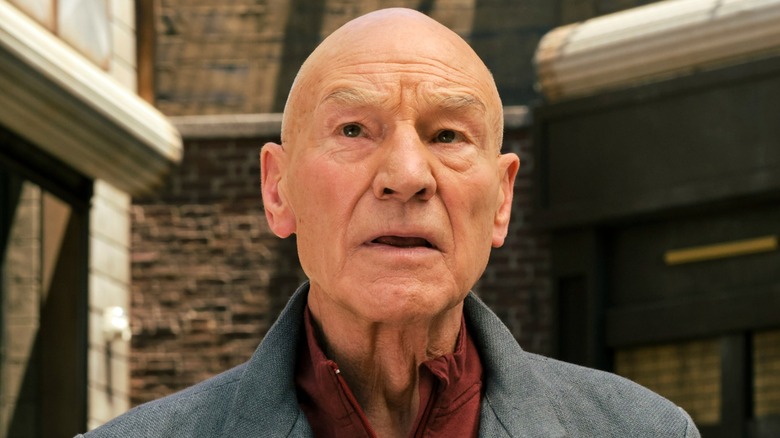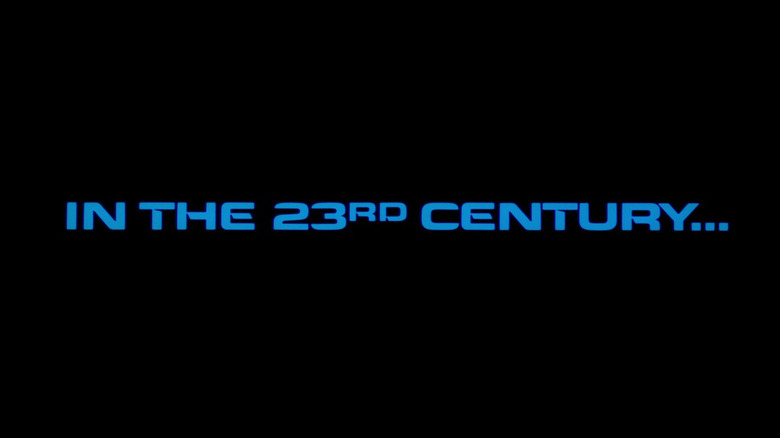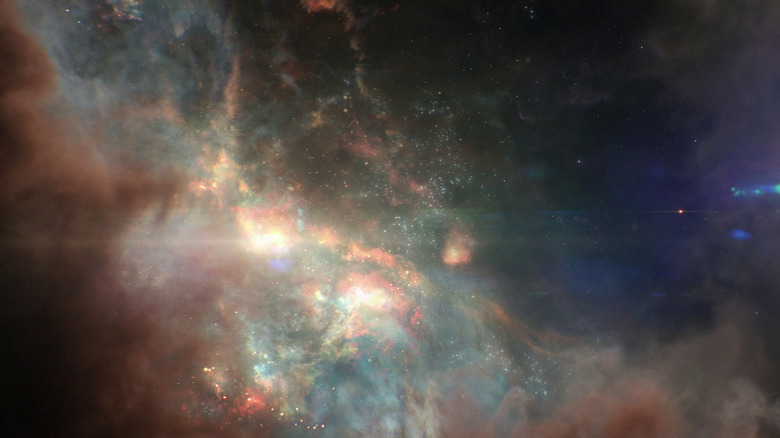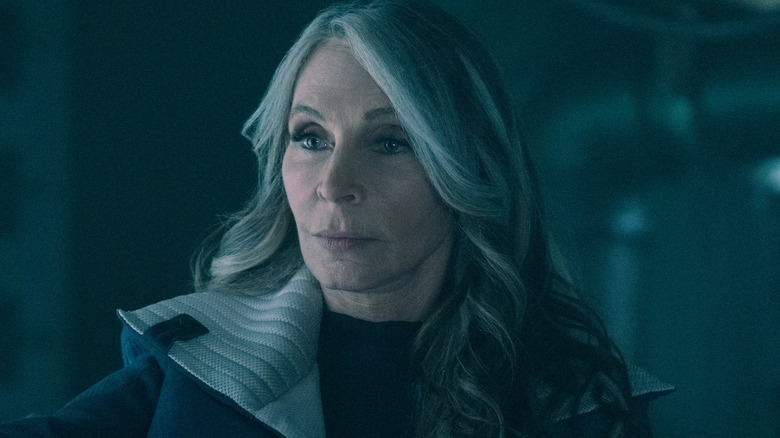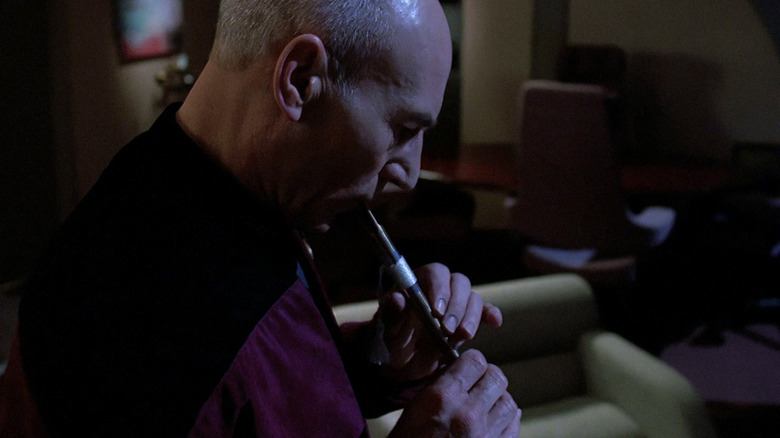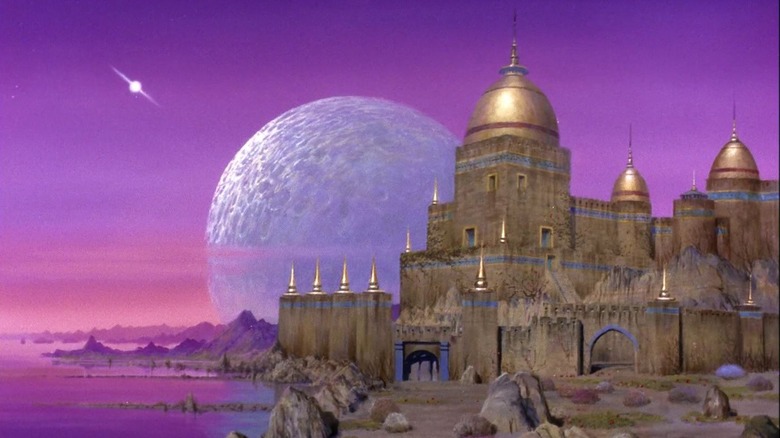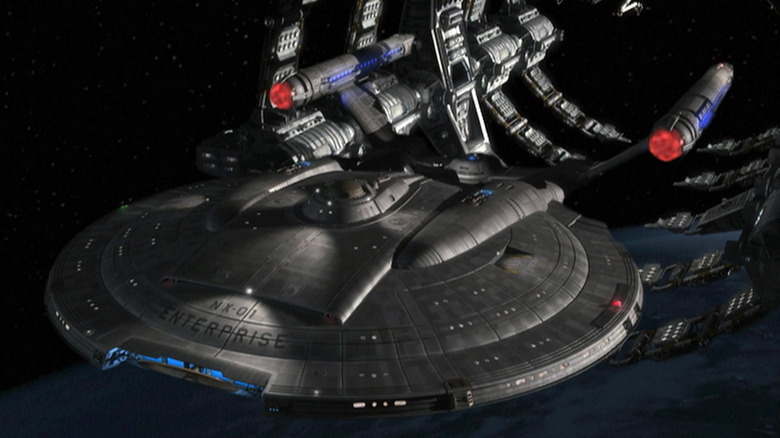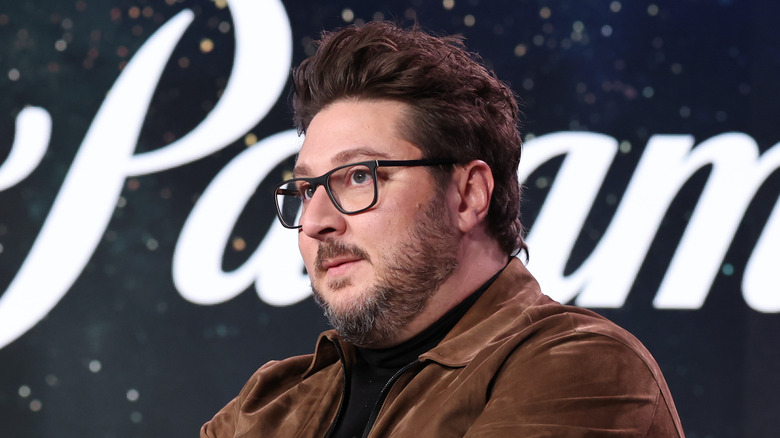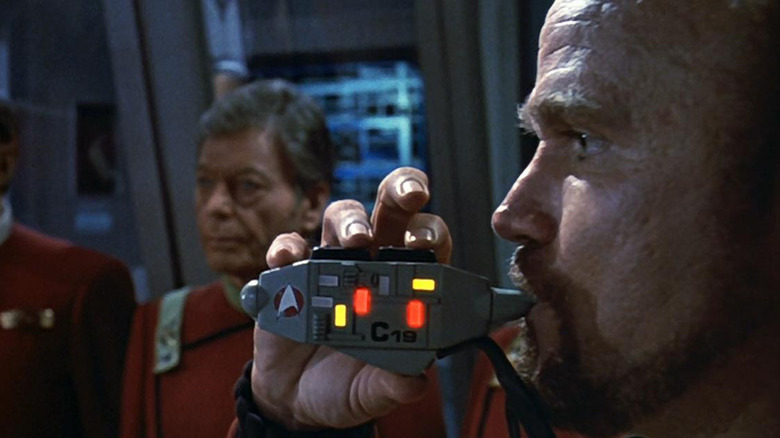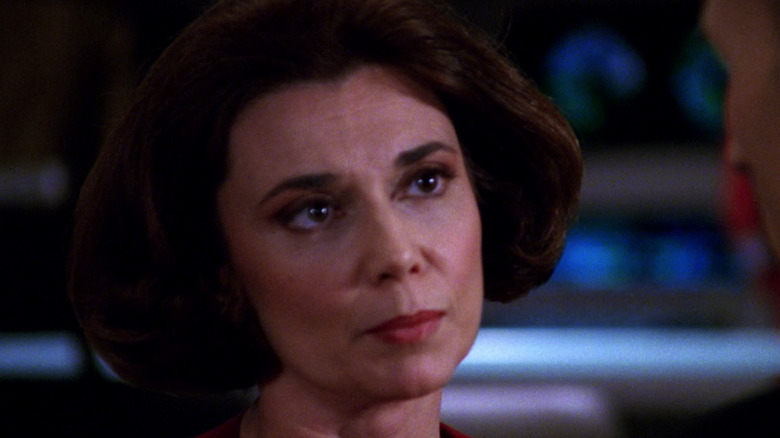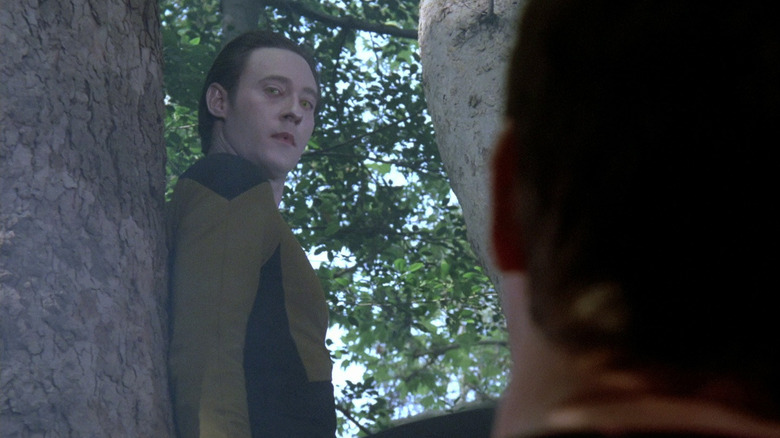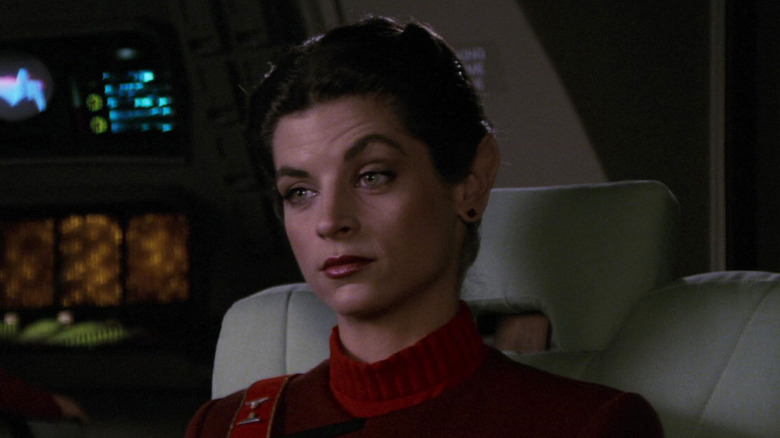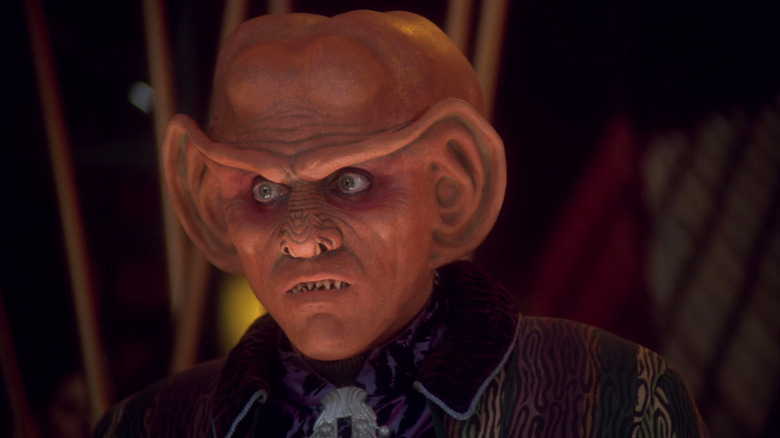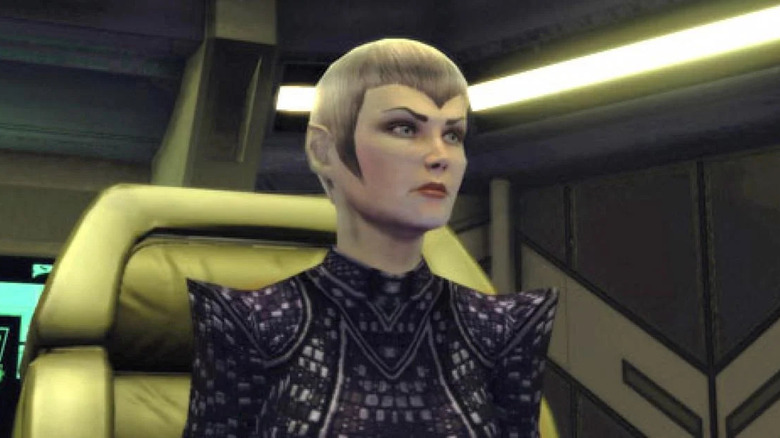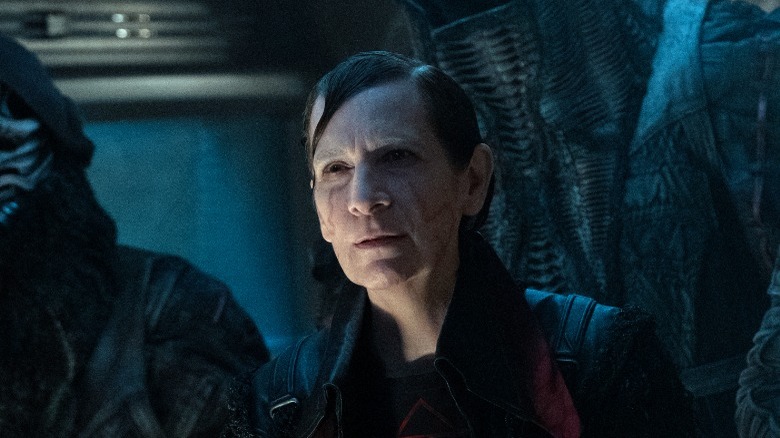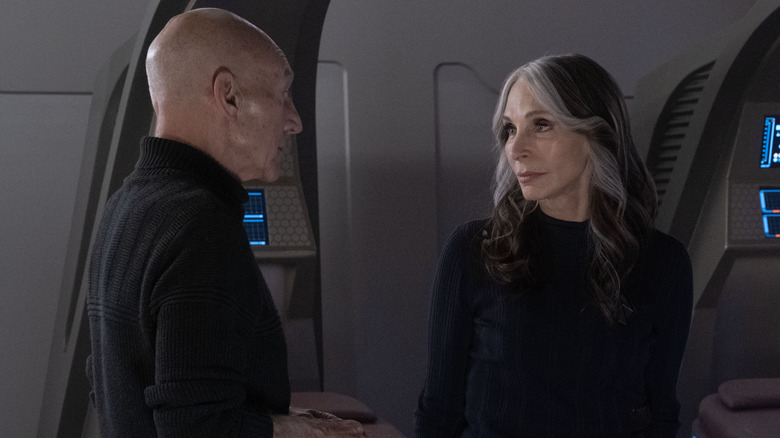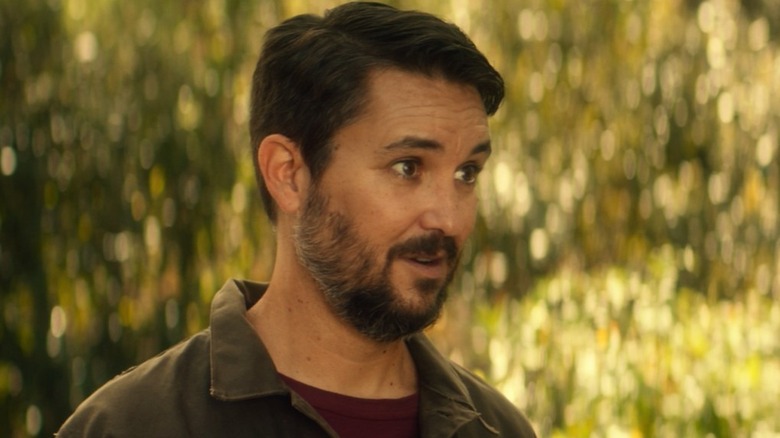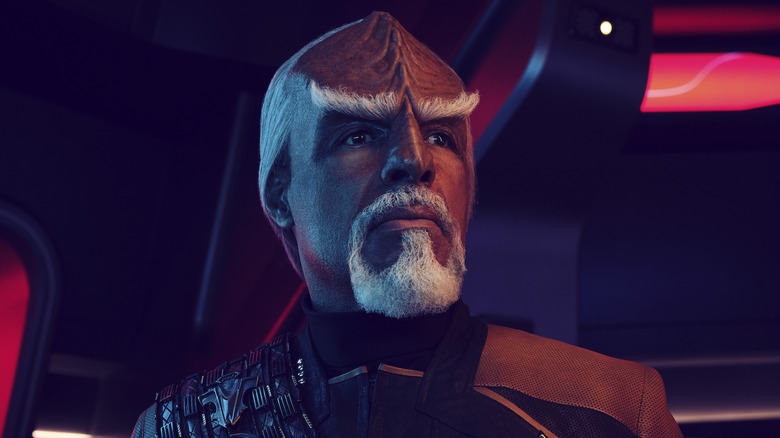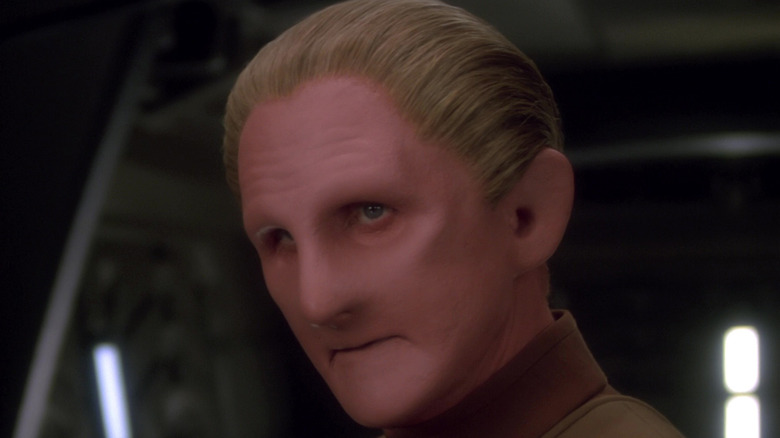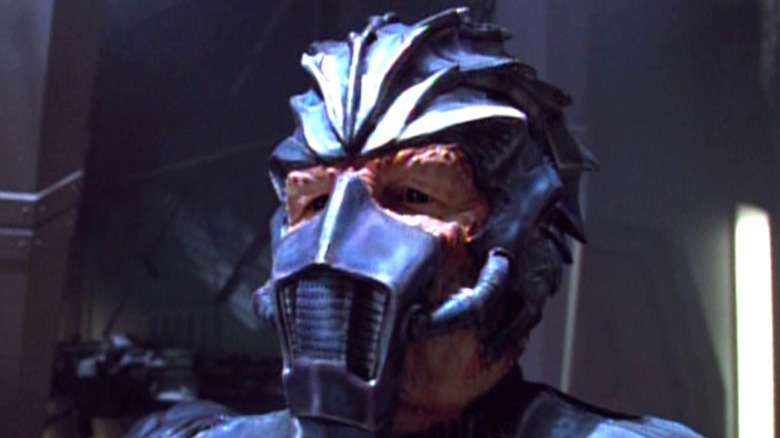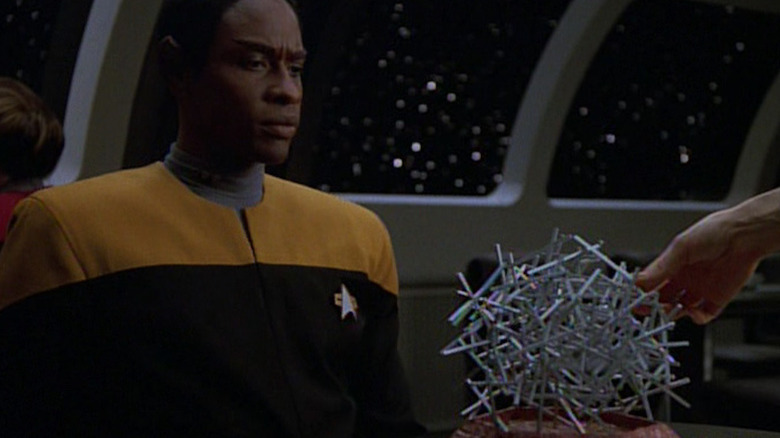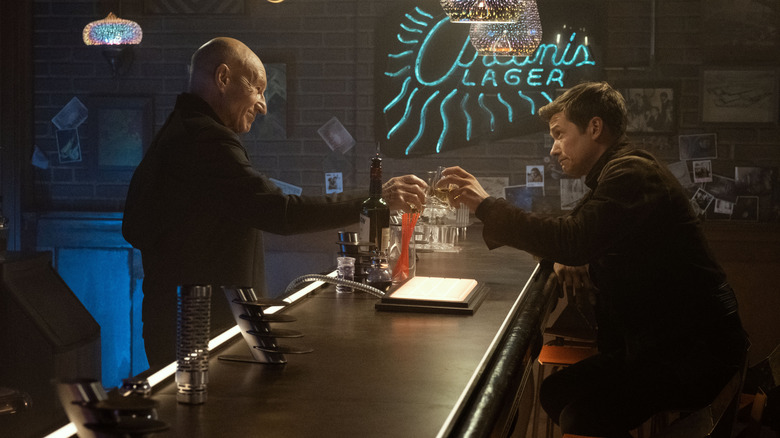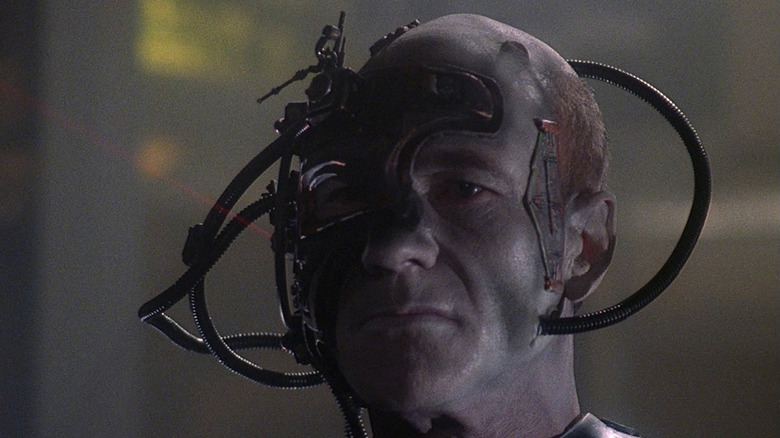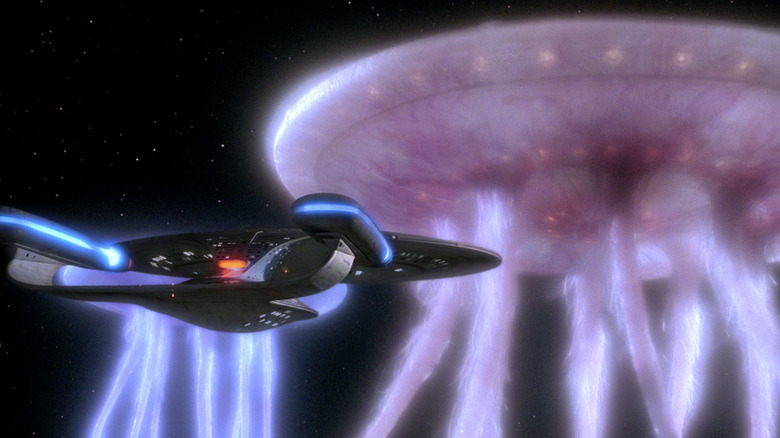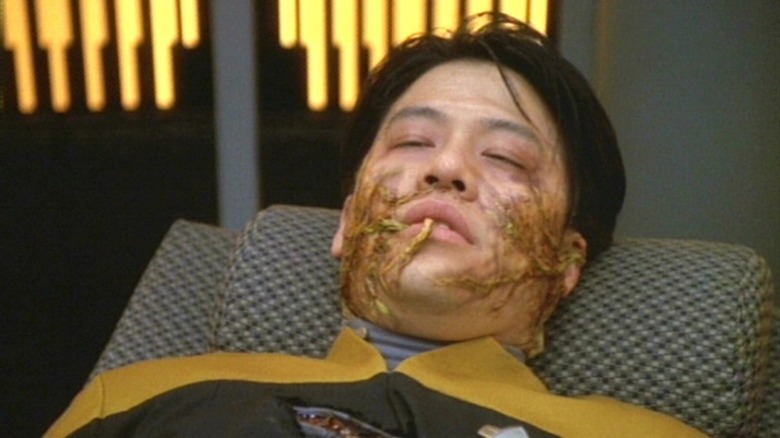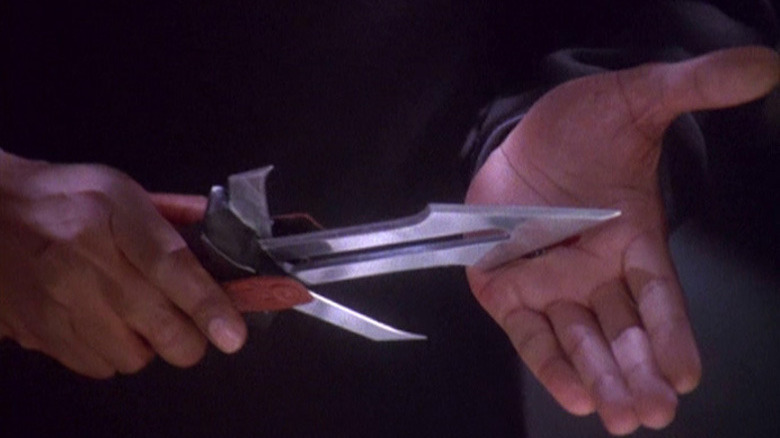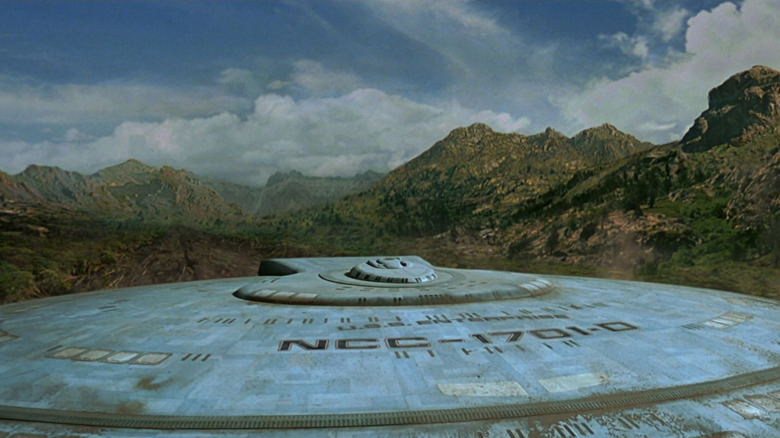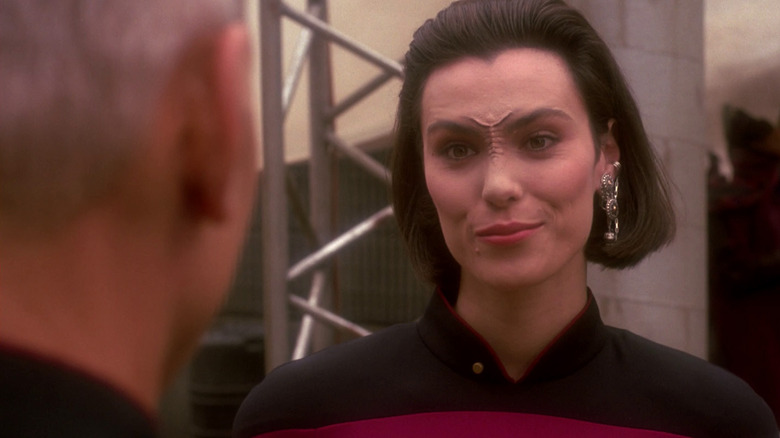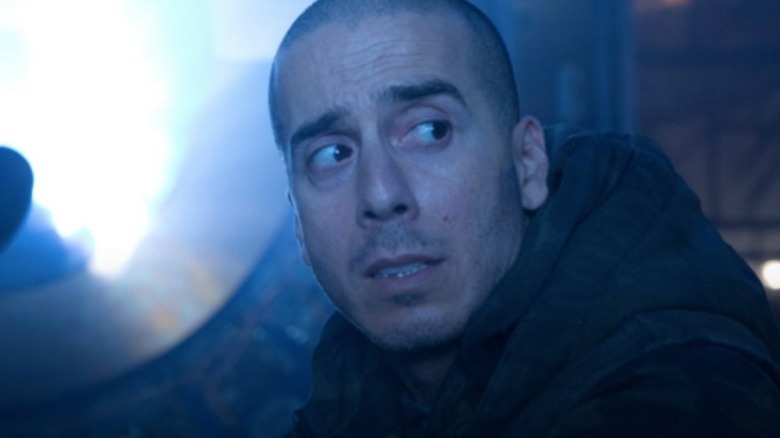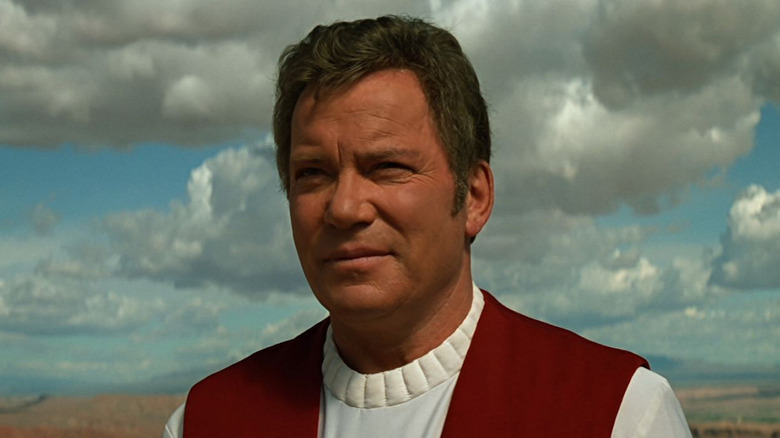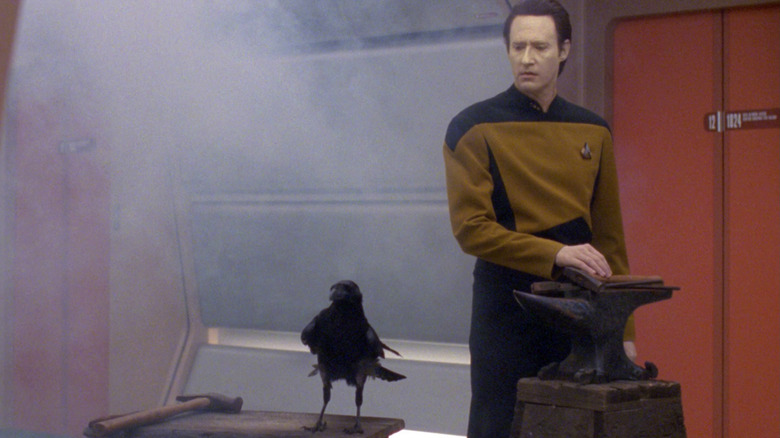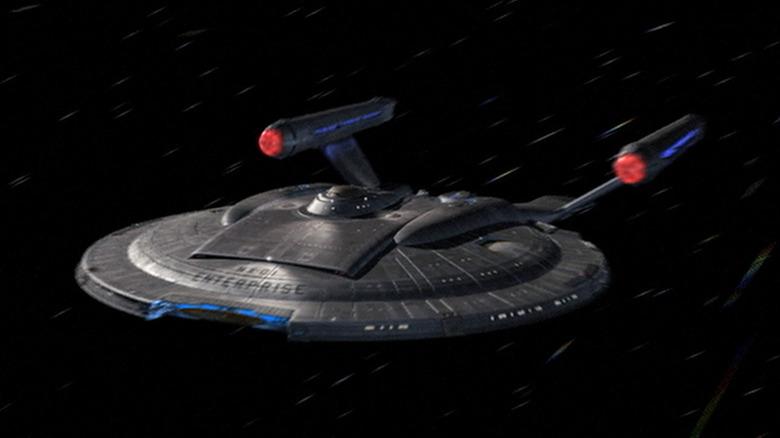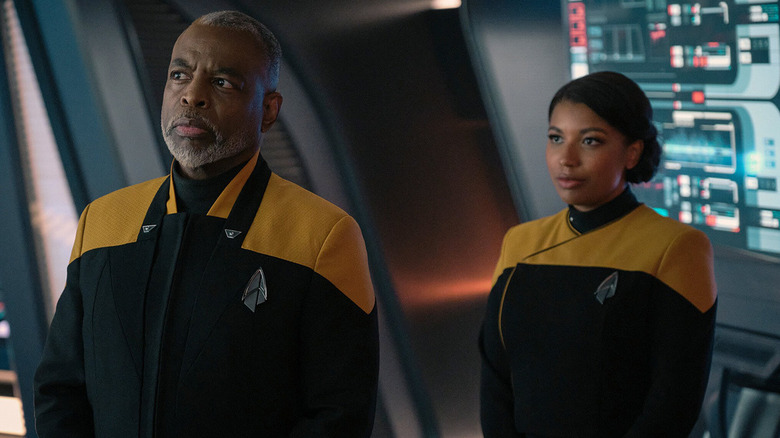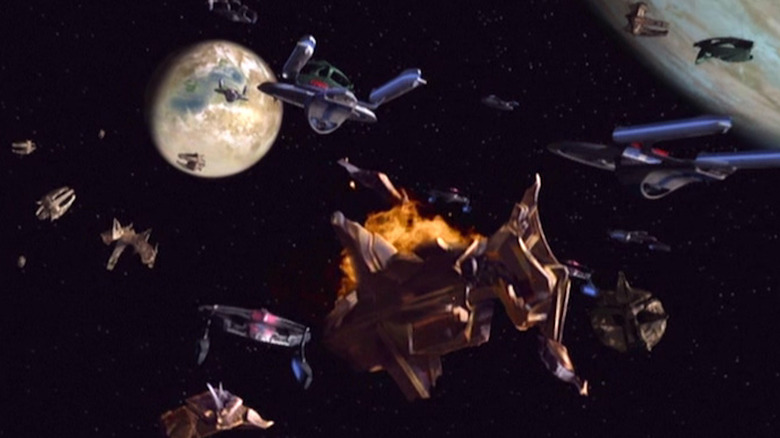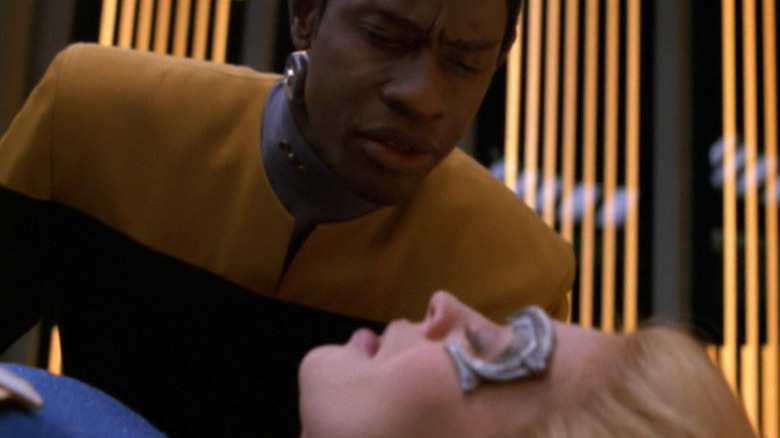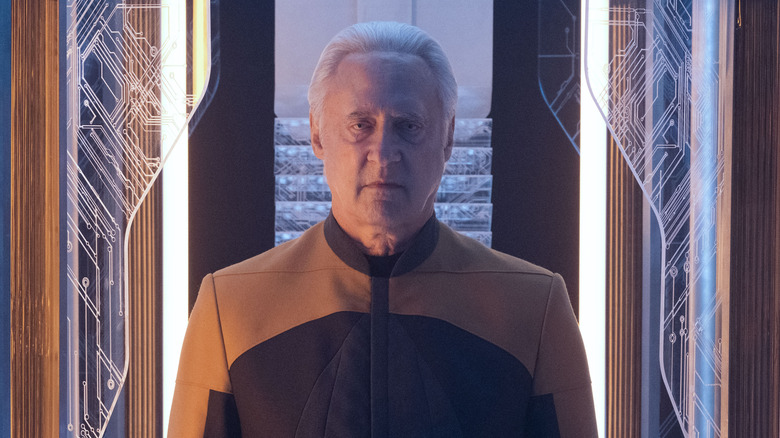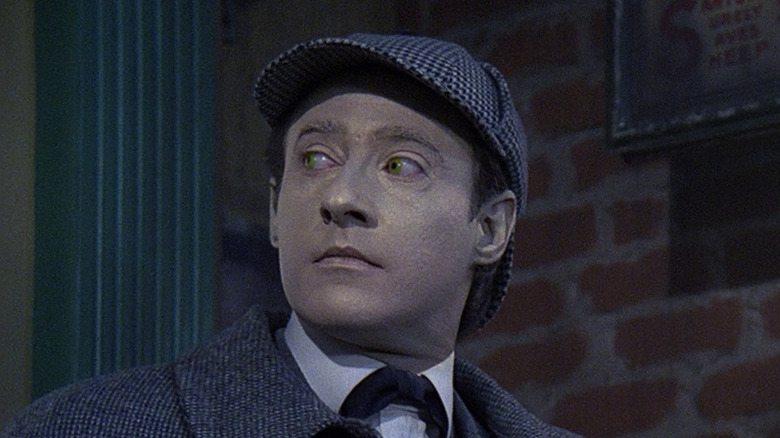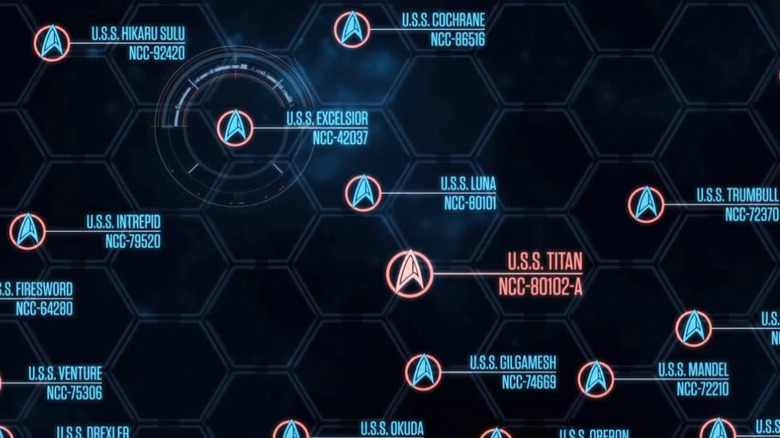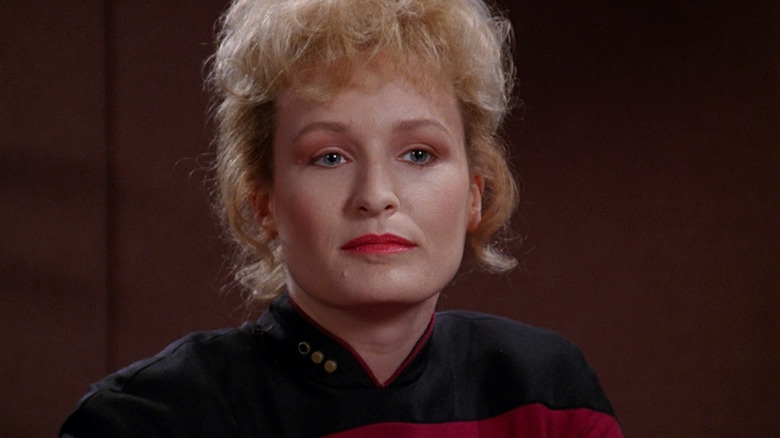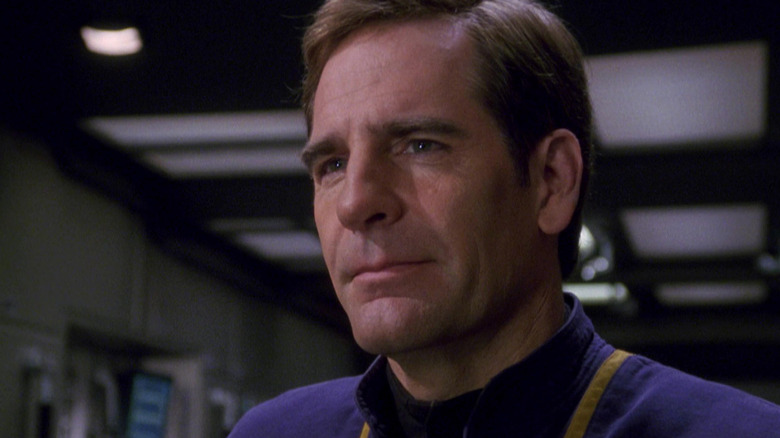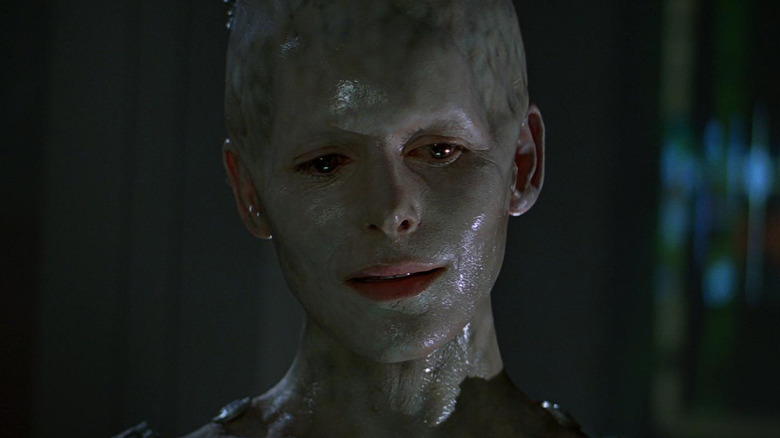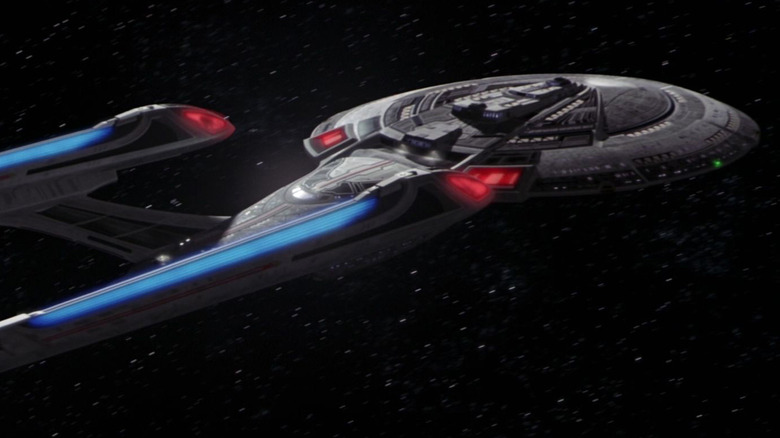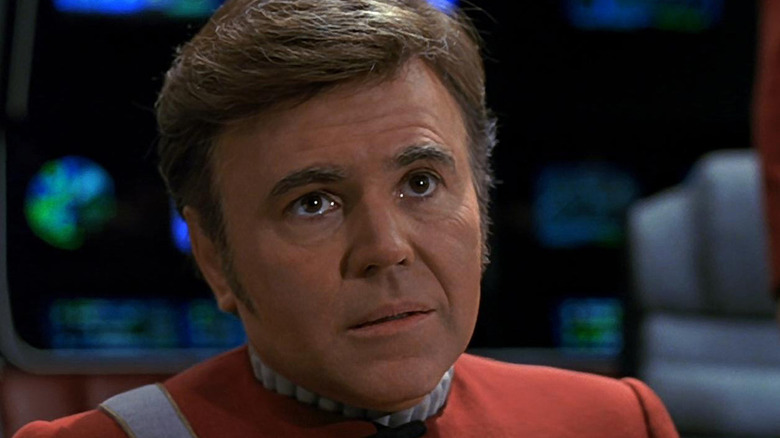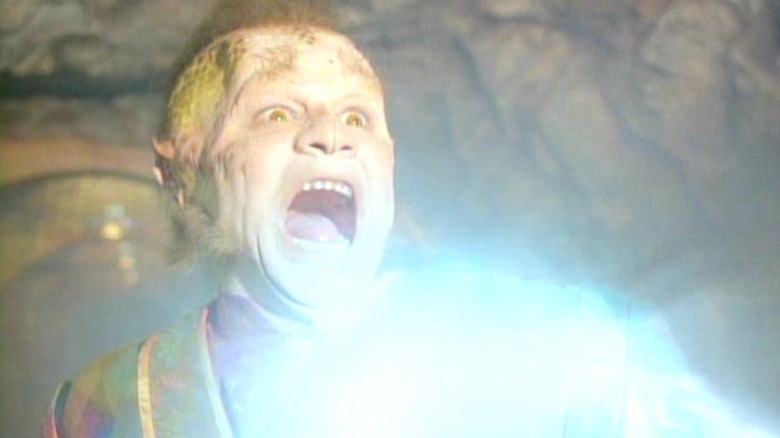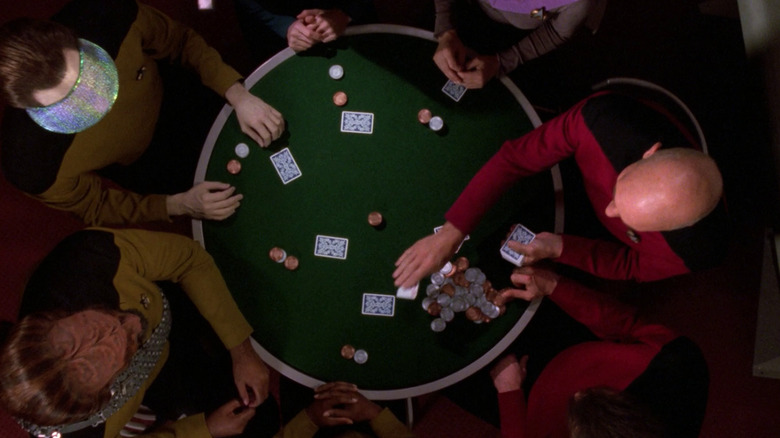Easter Eggs In Star Trek: Picard Season 3
After two seasons of half-hearted attempts to endear audiences to a new cast of supporting characters, the final ten episodes of "Star Trek: Picard" will reunite the Starfleet legend with his old crew from "Star Trek: The Next Generation."
Season 3 of "Picard" is essentially a fifth "The Next Generation" movie and a third attempt at giving one of the most popular casts from "Star Trek" a satisfying farewell. Not that there was anything wrong with the first try, of course, as the series ending "All Good Things..." still ranks amongst the best TV finales of all time. However, "Star Trek: Nemesis" was such a bummer that "Star Trek: Picard" spent most of Season 1 attempting to redeem it, and fans weren't exactly wild about how that went, either.
As such, Season 3 of "Star Trek: Picard" sees showrunner Terry Matalas spilling over the toybox and giving fans what they always want — more of the same thing they liked 20 years ago. That means a full "The Next Generation" cast reunion, nostalgia-fueled marketing, and, of course, about a million Easter eggs to reward longtime Trekkies for their encyclopedic knowledge of the canon. We've put our decades of obsessing over "Star Trek" minutiae to the test cataloging as many winks, nods, and name-drops as we can find in "Picard," from the obvious to the extremely obscure. Here are all the Easter eggs fans may have missed in "Picard" Season 3.
The season premiere wastes no time citing The Wrath of Khan as an inspiration
The series opens with the text "In the 25th Century..." in stylized blue typeface over black. This will be familiar to fans of "Star Trek II: The Wrath of Khan," which begins with the phrase "In the 23rd Century..." in that same print. This is the first signal that this season of "Star Trek: Picard" (particularly Episode 1) will borrow liberally from the popular film. In addition to a few plot beats throughout the season, the series has a definite aesthetic fondness for the entire "The Original Series" movie era.
There are several subtle nods in the production of the season premiere alone. The alarm klaxon in Beverly Crusher's ship indicating a security breach is the same one that sounds when Spock's quarters are invaded in "Star Trek III: The Search for Spock." Likewise, the style of the jacket that Beverly wears in the episode's teaser is reminiscent of the away team jacket from "The Wrath of Khan," which has a similarly broad collar. Later, when we get a look at the redesigned hand phasers, we can see that they've reverted to something closer to the swept-back models from the classic era, very much like those seen in "The Search for Spock" and "The Undiscovered Country."
Of course, there's also the design of the USS Titan-A, which Redditors have identified as a Neo-Constitution Class refit. It cuts a silhouette that's closer to the refit Constitution-Class of "The Original Series" films than any of "The Next Generation" era ships, and throughout the season, it appears that rectangular warp nacelles have come back into fashion at the turn of the 25th century.
The series premiere of Picard gets a nod in the season's opening minutes
Season 3 of "Star Trek: Picard" is plainly designed to be consumed independently from the first two seasons of the series. Most of the original characters introduced earlier are absent or have reduced roles, and there's even a new opening title sequence. Still, the series does make a subtle acknowledgment of its own origins.
Our first images of the season are a brief montage of beautiful and peaceful images of stellar phenomena, with an early 20th-century ballad playing underneath it. This is also how the first episode of the series, "Remembrance," begins. In that episode, the soundtrack was "Blue Skies" by Irving Berlin, as performed by Bing Crosby — a song that Data sang at Riker and Troi's wedding in "Star Trek: Nemesis." Season 2 of "Picard" also uses a 20th-century ballad in its opening episode, in that case, "Je Ne Regrette Rien" by Edith Piaf.
This time, our opening number is "I Don't Want to Set the World on Fire" by The Ink Spots. This tune has no prior history with "Star Trek," but might be familiar to gamers in the audience, as it features in the "Fallout" series. It was the center of a TikTok meme in 2022, in which users painted their noses and flared their nostrils as if they were the singer's mouths. This is probably — unrelated.
Fans are prepared to meet Beverly Crusher before she appears
Episode 1's first scenes are set aboard an unfamiliar starship, the Elios, where the camera pans across a cluttered desk. Eagle-eyed fans will quickly put together that this workspace belongs to Dr. Beverly Crusher, thanks to a number of obscure visual clues.
These include classic drama masks (recalling Crusher's love of theater) and the same sort of flowers that she tends in her quarters in "The Next Generation" episode "Cause and Effect." Her computer is playing back one of Captain Picard's log entries from "The Best of Both Worlds," and the following log in the queue is the one that opens "Encounter at Farpoint," the premier episode of "The Next Generation." She has a plaque awarded to a medical away team as honorary citizens of Cor Caroli V, likely in recognition of a mission that we hear about (but never actually see) in "The Next Generation" episode "Allegiance."
Since these are all pretty obscure references, we then pan down to a more obvious one — the foot locker of Beverly's late husband, Lieutenant Commander Jack Crusher.
Picard's office is a The Next Generation museum
Just as in previous seasons of "Star Trek: Picard," Jean-Luc's home in La Barre, France, displays a number of artifacts that are familiar to Trekkies. A few of these items receive some special attention in the scene where Picard does some spring cleaning with his girlfriend, Laris.
First, of course, is the large painting of the USS Enterprise-D that used to hang in his ready room in "The Next Generation," which he considers giving to Geordi La Forge and the Starfleet Museum. Just below it there's also a sextant on the mantle that may be the one from Picard's quarters. The Mintakan tapestry from "Who Watches the Watchers" that used to drape over his chair on both Enterprises still adorns the chair behind his desk at home. There's a Bajoran memento, gold models of both Enterprise-D and Enterprise-E, and, finally, his Ressikan flute from "The Inner Light," perhaps the most precious of all his mementos as it is his only keepsake from his lifetime of memories on the long-dead planet Kataan.
Later, he sits handwriting a note (whose print we don't get a good look at), and the Kurlan naiskos — a precious archeological artifact and a gift from his mentor Professor Galen — can be seen on his table. We get one additional reference here, as the authorization code that Picard uses to decrypt Beverly's message is "Picard 4 7 Alpha Tango," the same security code that he uses to activate the self-destruct sequence on the Enterprise-E in "Star Trek: First Contact."
Riker and Picard's conversation has nods to multiple past Star Trek stories
After receiving Beverly's encrypted distress call, Picard meets up with his old friend Riker at the Ten Forward lounge in Los Angeles. While reminiscing, Riker mentions that the crew of the Enterprise had previously used Beverly's "myriad" codec to encrypt their transmissions while on a mission to Rigel VII. However, Rigel VII is a planet whose first and only appearance is in the original "Star Trek" pilot, "The Cage," from 1965 (though this footage would later be reused in the classic 1966 two-parter "The Menagerie"). The incident to which Riker refers has never been depicted or mentioned before on screen.
The "hellbird" virus that offers the final clue to decoding Beverly's location is another new addition to the canon, a background plot retconned into "The Best of Both Worlds." We learn that the Borg attempted to foul the Enterprise's navigation using a computer virus while Picard was held captive as Locutus of Borg.
References to never-before-mentioned incidents such as these are a pleasant reminder that our heroes have had adventures beyond those that have been the center of existing "Star Trek" episodes and that even the stories we know have complications to which the audience isn't always privy. The Enterprise is a big ship, after all, in an even bigger galaxy.
Frontier Day is celebrating Star Trek's least-loved prequel series
When Picard summons Riker to the Ten Forward bar in Los Angeles, we learn that there is an upcoming celebration planned for Frontier Day, described as Starfleet's 250th anniversary. For this date to line up with where we appear to be in the show's timeline, it would have to be a celebration not of Starfleet's founding, but of its first deep space mission, which launched in 2151 under the command of Captain Jonathan Archer.
The adventures of this first Starship Enterprise (also known as the NX-01) are the subject of the prequel television series "Star Trek: Enterprise," which aired on UPN from 2001 to 2005. Out of the five "legacy" live-action "Star Trek" series, "Enterprise" is the one that tends to get the least love from the current crop of creators, though there is the occasional nod to its historical significance in the universe, such as the christening of Archer Spacedock on Season 4 of "Star Trek: Discovery."
Incidentally, the souvenir starship models up for sale in Ten Forward appear to be items from the Eaglemoss Collection of "Star Trek" starships. Eaglemoss declared bankruptcy during the height of the COVID-19 pandemic after producing over 400 unique starship models from across the "Star Trek" canon.
M'Talas Prime brings showrunner Terry Matalas full circle
M'Talas Prime, the neon-lit city planet where Commander Raffi Musiker is working undercover for Starfleet Intelligence, is named for Picard showrunner Terry Matalas, who also wrote this episode. However, he didn't name the planet after himself — the planet was first introduced in dialogue on a 2002 episode of "Star Trek: Enterprise" by showrunner Brannon Braga, for whom Matalas was working as an assistant. Matalas would return to "Star Trek" years later to become co-showrunner of "Picard" Season 2 with Akiva Goldsman before finally taking the reins for its final run.
Matalas' fingerprints are all over this season. Fans of his previous series, Syfy's "12 Monkeys," will recognize the actor playing Captain Shaw. That's Todd Stashwick, who played the villainous Deacon on "12 Monkeys." He also guest starred on a 2004 episode of "Star Trek: Enterprise" as Talok, a Vulcan officer who turns out to be an undercover Romulan spy. Don't be surprised if you see a few other cast members from "12 Monkeys" crop up over the course of the season.
The arrival on the Titan mimics famous sights and sounds from Star Trek films
Picard and Riker's shuttle approach towards the USS Titan is very evocative of similar sequences in which Captain Kirk and company return to the refitted USS Enterprise in the various chapters of the original "Star Trek" film series. Once Picard and Riker are aboard the Titan, references to "Star Trek II: The Wrath of Khan" continue as a crewman blows into a digital boatswain's whistle to signal their arrival. The same ritual is performed when Kirk is welcomed aboard the Enterprise in "The Wrath of Khan," and the prop used is almost identical to the one played by Yeoman Burke in "Star Trek VI: The Undiscovered Country."
The influence of the "The Original Series" era of "Star Trek" films extends to non-diegetic sound choices as well. The arrangement of the musical score when Picard and Riker enter the bridge of the Titan — and the entire sequence of the ship's departure from Spacedock — are extremely reminiscent of James Horner's score from a parallel scene in "The Wrath of Khan." Though composer Stephen Barton also incorporates an original motif for this series and Jerry Goldsmith's famous theme from "The Motion Picture" and "The Next Generation," his arrangements evoke the feeling of "The Wrath of Khan" and "The Search for Spock" for viewers who may not recognize it outright.
If you want to hear the inspirations for these compositions, listen to "Enterprise Clears Moorings" from "The Wrath of Khan" soundtrack. There's even a brief quote from Cliff Eidelman's score from "The Undiscovered Country" as the ship emerges from the space dock doors.
Raffi's search for the Red Lady is an Easter egg hunt of its own
When Raffi asks the computer to name all the "big events" coming up in the next few months (an pretty ridiculous request considering we're talking about the entire galaxy here), the computer displays a whopping three results. First, the Gratitude Festival, a Bajoran holiday first seen in the "Deep Space Nine" episode "Fascination." Empire Union Day is a Klingon holiday mentioned only in a quasi-educational audio tape called "Power Klingon," released in 1993 as part of a series of books and tapes about the Klingon language by its inventor, linguist Marc Okrand. Long out of print and remembered only by those who study the language, this is about as deep as deep-cut references get.
The "Red Lady" Raffi learns about from her contact on M'Talas turns out to be a codename for a statue being dedicated at a Starfleet Recruitment Center. The statue honors Captain Rachel Garrett, commander of the USS Enterprise-C, whose only appearance is in "The Next Generation" episode "Yesterday's Enterprise." Garrett is killed in battle while coming to the aid of a Klingon colony under Romulan attack. This is a more pivotal moment in history than it seemed, as Garrett and her crew's sacrifice helped to avert decades of war.
Also on-screen during this scene are images of a few starships that have not made canon appearances before, including the Odyssey-Class USS Enterprise-F, which was designed via a fan contest for the video game "Star Trek Online."
The show's credits are loaded with hints and references
Even the end credits of "Star Trek: Picard" offer a few Easter eggs, some of which don't become apparent until after they've been paid off later in the season. To avoid spoilers, we'll highlight just one, which doesn't require any foreknowledge to interpret. Under the co-executive producer credits, a few staves of musical notation are briefly highlighted. It's a melody in 6/8 time in the key of D Major. If you can read music, you might recognize this tune as "Pop Goes the Weasel," which Trekkies will remember is the song that Data is trying to whistle when Will Riker first befriends him in "Encounter at Farpoint." Riker fondly recalls this moment after Data's death in "Star Trek: Nemesis."
Of course, there's the music that plays under the credits themselves, which contains Jerry Goldsmith's theme from the most beloved of "The Next Generation" films, "Star Trek: First Contact." Like in the end credits of that film, it eventually segues into Goldsmith's tried and true "Star Trek Main Title" fanfare. Once the animated credits have ended, the final set of closing credits are displayed in the blue typeface used in the credits for "Star Trek: The Next Generation." This same font was borrowed for the credits of "Star Trek: Lower Decks," which is likewise awash in "The Next Generation" nostalgia.
Shuttlecraft Saavik pays tribute to a fan favorite
In the opening episode of Season 3, Admiral Picard and Captain Riker commandeer one of the USS Titan's shuttlecraft for an unauthorized rescue mission to Dr. Beverly Crusher's ship, the SS Eleos. However, In the following chapter, "Disengage," the shuttle is destroyed. As the wreckage flies towards the camera, we get a clear look at the shuttle's name: the Saavik.
The vessel's namesake is a junior officer introduced in "Star Trek II: The Wrath of Khan," where she was portrayed by Kirstie Alley in her first major film role. Lt. Saavik was Spock's protégé and seemed positioned to take his place as a regular member of the Enterprise crew after Spock's death at the end of that film. However, when Spock actor Leonard Nimoy decided not to leave the franchise, Saavik was gradually given smaller roles (and a different actor, Robin Curtis) in the next two films before disappearing altogether. That is, until a recent official "Star Trek" franchise Instagram post revealed that Saavik eventually rose to the rank of captain and took command of the first USS Titan in the late 23rd century, making the shuttlecraft's name a tribute to her legacy.
In our universe, the original actress to play Saavik, Kirstie Alley, passed away from colon cancer in December 2022, and the shuttle may have been christened in her memory.
Ferengi broker Sneed has some famous friends
Any time you see a wall of text on a display in "Star Trek," you're bound to find a few Easter eggs. "Disengage" features quite a few in the criminal record for the Ferengi gangster Sneed. Sneed's list of known associates includes some familiar names from "Star Trek: Deep Space Nine." Quark of Ferenginar is, of course, the series' nefarious bartender, though by this point in the "Star Trek" timeline he's also the owner of a franchise of bars and gambling establishments bearing his name, as seen on "Star Trek: Lower Decks" and in previous seasons of "Picard." Brunt is Quark's nemesis from the Ferengi Commerce Authority, played by Star Trek's man of a thousand faces, Jeffrey Combs. Morn of Luria is Quark's most steady customer, appearing in 93 episodes of "Deep Space Nine" and never speaking a word.
The final name on Sneed's list of known associates is Thadiun Okona, a smuggler and playboy who first appeared in the infamously campy episode of "Star Trek: The Next Generation" called "The Outrageous Okona" and has since appeared in animated form on both "Lower Decks" and "Star Trek: Prodigy." We can now add a reference in "Picard" to his surprisingly illustrious resumé.
As for Sneed himself, he's portrayed by Aaron Stanford, who starred as James Cole on "Picard" showrunner Terry Matalas' previous series, "12 Monkeys." The name James Cole also appears on Jack Crusher's list of aliases in this episode.
T'Luco's rap sheet references Star Trek Online
While investigating the destruction of the Starfleet Recruitment Center, Commander Raffi Musiker looks into the criminal record of the Romulan outlaw Lurak T'Luco, who Starfleet has named as the perpetrator. Raffi disagrees, believing him to be too small time for such a serious crime. Over Raffi's shoulder, we get a quick look at T'Luco's history, which references two worlds that have never been seen in canon but nevertheless have long histories in the "Star Trek" franchise.
The planets Vendor and Rator III were both first mentioned in a 1973 episode of "Star Trek: The Animated Series," entitled "The Survivor." The shapeshifting Vendorians introduced in that episode wouldn't make another appearance until "Lower Decks" brought them back for a gag in 2020, but Rator III has taken on a more important role in "Star Trek" history via the massively multiplayer role-playing game "Star Trek Online."
In the game's backstory (expanded upon in the tie-in novel, "Star Trek Online: The Needs of the Many") Rator III briefly becomes the seat of the Romulan Empire after the destruction of Romulus. Though "Star Trek Online" is not considered canon, this Easter egg would seem to verify Rator III's location and prominence within the shattered Romulan Empire.
Amanda Plummer is a Star Trek legacy
Season 3 of "Star Trek: Picard" pays homage to the style and tone of the original six "Star Trek" feature films, so it's only appropriate that the season's antagonist be cut from the same cloth as those classic movie villains. The casting of Amanda Plummer as the dastardly Captain Vadic is surely no accident — her late father, Christopher Plummer, portrayed the Klingon General Chang in "Star Trek VI: The Undiscovered Country" in 1991. Their characters have no direct relation, but there are definitely some stylistic connections beyond their actors' family ties. Both antagonists plainly relish in their villainy, indulging in flowery speeches and theatrical intimidation.
The fact that both Chang and Vadic twirl around in their big captain's chairs and order their crews to open fire with casual flicks of the wrist might just be a coincidence, or it could be a knowing tribute from a daughter to the father in whose footsteps she treads. However, it's almost certainly deliberate that, during Vadic's menacing viewscreen conversation in "Disengage," the sound designers for "Picard" have brought back the same ominous communications klaxon used to punctuate General Chang's hails in "Star Trek VI." It's exactly the sort of detail that someone would only notice if they'd watched "The Undiscovered Country" a dozen times — which, of course, we have, and we appreciate it.
Little production flourishes like this, combined with Plummer's performance, make Vadic a delightful throwback to the franchise's illustrious past.
Beverly and Jean-Luc's split has echoes of The Wrath of Khan
"Picard" Season 3 isn't shy about borrowing from "The Wrath of Khan," but the reveal of Jean-Luc's long-lost adult son might be the most blatant reference to the franchise's most popular film. In "Star Trek II," the audience learns that Kirk fathered a son before the events of "The Original Series," but that the boy's mother, Dr. Carol Marcus, retained sole custody in order to assure him a stable upbringing. In "Picard" Season 3's third episode, "Seventeen Seconds," we finally hear from Dr. Beverly Crusher about her decision to drop off the map and raise their son alone rather than have Jean-Luc be a part of his life.
While telling her tale, Beverly also name-drops a few curios from the "Star Trek" universe. Her last date with Jean-Luc was on Casperia Prime, a planet mentioned on Deep Space Nine as being "The Vacation Capital of the Horvan Sector." Both DS9's Jadzia Dax and Julian Bashir have planned to visit there but neither actually made the trip, and thus the audience has never had a first-hand look. Beverly also mentions the Donatra Sector, which shares the name of a Romulan Commander from "Star Trek: Nemesis."
It's also worth mentioning that, in the alternate "First Splinter Timeline" of Star Trek novels, Beverly and Jean-Luc have a son named René Jacques Robert Francois Picard who is born around the same time as the Prime Timeline's Jack Crusher.
Beverly's lost a lot of family to the stars
While explaining her long absence, Beverly lists the family members that she has lost. First, her parents, whose cause of death has never been mentioned in canon. Previously, we've known only that she was raised by her grandmother, but this seems to confirm the backstory established in "Star Trek" novels that her parents were space explorers whose vessel was destroyed in an attack by hostile aliens.
The death of her husband, Jack, is a well-established but barely-explained piece of "Star Trek" lore that goes all the way back to the first episode of "The Next Generation." Jack Crusher (Sr.) was the first officer aboard the USS Stargazer under Jean-Luc's command and was killed on an away mission. Jean-Luc has been weighed down with guilt over his death ever since, further complicating his romantic feelings for his late friend's widow. Further details about this tragedy have only been explored in non-canonical novels, such as 1991's "Star Trek: Reunion" by Michael Jan Friedman.
Her other son, Wesley, left to explore inter-dimensional time and space with the being called the Traveler at the end of "Star Trek: The Next Generation." Apart from dropping in to attend Riker and Troi's wedding in "Star Trek: Nemesis," Wesley has been seen only once since, in the finale of "Picard" Season 2, where we learn that he has continued to serve as a member of "the travelers," an inter-dimensional watchdog group that protects the timeline from incursions.
Worf's resume summarizes his history across two series
When Worf introduces himself to Raffi Musiker on M'Talas Prime, he reads off a list of impressive-sounding titles, accumulated over the course of his unprecedented 281 appearances across "The Next Generation," "Deep Space Nine," and the feature film series. To begin with, he is, of course, the Son of Mogh, a Klingon dignitary who was killed by Romulans when he was a young boy (his biological mother has never been named in canon). He is also the Son of Sergei, of "House Rozchenko," referring to his adoptive human parents Sergei and Helena Rozchenko of Earth.
Worf also names himself as a member of the House of Martok, the family that he was inducted into during "Deep Space Nine" after breaking out of Dominion prison with General Martok. Worf is the "Slayer of Gowron," referencing when he defeated the dishonorable Klingon High Chancellor in single combat and installed Martok in his place in the late DS9 episode "Tacking into the Wind."
Finally, he's "Bane to the Duras Family," his nemeses since early in "The Next Generation." Duras is the house of the Klingons who betrayed his parents to the Romulans and later murdered his mate, K'Ehleyr. Worf, in turn, has killed three of the last four heads of the House of Duras — Duras himself and his two sisters, Lursa and B'Etor — and bested their heir, Toral, in combat.
A departed friend from Deep Space Nine plays an invisible role in this season of Picard
The episode, "Seventeen Seconds," reveals that the masterminds behind the attack on the Starfleet Recruitment Center are Changelings, major antagonists from "Star Trek: Deep Space Nine." As their name suggests, Changelings are shapeshifters whose natural state is a liquid but have the ability to perfectly imitate any person, creature, or object they choose. They command the Dominion, an empire even more vast and powerful than the Federation, located in the distant Gamma Quadrant. The Dominion War takes place over the course of multiple seasons of "Deep Space Nine," but they haven't been heard from since.
Here, Worf tells Raffi that he has been contacted by a friend from the Changelings' Great Link who warned him that a splinter group of Changelings is aiming to attack the Federation. This "man of honor" could be none other than Odo, the former Chief of Security of space station Deep Space 9. Though a Changeling himself, Odo fought on the side of the Federation in the Dominion War, serving with then-Lt. Commander Worf throughout the conflict.
After the Dominion's surrender, Odo returned to the Great Link in order to cure his people of a deadly virus and help to foster a lasting peace. Sadly, Odo will not be making any appearances in "Picard," as actor, René Auberjonois, passed away in 2019.
Picard encounters a Voyager villain off-screen
The episode "No Win Scenario" opens with a flashback to five years before the events of this season, in which retired Admiral Jean-Luc Picard is enjoying a meal at Guinan's Ten Forward lounge in Los Angeles. Fans will note that there are still Frontier Day posters on the wall despite the event being five years away, which is likely a production oversight.
While there, a group of young officers asks Picard about his encounter with the Hirogen, a species of ritualistic hunters who made their debut in "Star Trek: Voyager" — hence the mention of Admiral Janeway. The adventure in question isn't one that we've seen or heard of before and would have taken place between the film "Star Trek: Nemesis" and the earliest flashbacks in "Star Trek: Picard." This isn't the only reference to a Hirogen on "Picard," however, as one of the ex-Borg seen on the Artifact in the Season 1 episode "Nepenthe" is an assimilated Hirogen.
Later in the episode — when we cut back to this conversation — Picard is regaling his admirers with the story of the classic "The Next Generation" episode "Darmok," in which Picard attempts to survive on a hostile world with an alien captain who speaks only in impenetrable references to his own popular culture and mythology. Of all his famous adventures aboard the Enterprise-D, it's the one that Picard would seem most likely to enjoy recalling, as it's a dilemma that was solved through patience, compassion, and communication. It also happens to be one of the best episodes of "The Next Generation."
Ensign Foster's quarters contain artifacts from DS9 and Voyager
When Seven of Nine first searches transporter officer Foster's quarters near the start of "No Win Scenario," there's a familiar artifact on his desk: a messy stack of thin metal cylinders arranged in a shape like a tumbleweed. This is kal-toh, a Vulcan strategy game enjoyed by Voyager's Lieutenant Commander Tuvok and other members of the Voyager crew. Seven is particularly adept at the game and can be seen effortlessly demolishing veteran player Tuvok in the episode "The Omega Directive." Seven has also been seen teaching the game to then-girlfriend Raffi Musiker in the final moments of the "Star Trek: Picard" episode "Et in Arcadia Ego."
Later in "No Win Scenario," Captain Shaw suggests that Seven search Foster's quarters again to find a pot or vase in which Foster's changeling imposter may have hidden while sleeping in liquid form. Lo and behold, Seven checks inside a light fixture and finds a bucket that's more or less identical to the one that Constable Odo of "Deep Space Nine" used to sleep in.
This is a pretty silly inclusion, given that Odo's bucket is not a traditional Changeling artifact but something he would have acquired from the Cardassians long before he even knew that other Changelings existed. While Odo has since joined the Great Link, which would immediately share the knowledge of this habit with the entire species, it's unlikely that the Changelings — whose goal is to destroy the Federation — would want to honor his peoples' one and only traitor.
Picard explains away one of Voyager's silliest contrivances
"Star Trek: Picard" finally clarifies a baffling piece of "Star Trek" canon involving the franchise's famous simulator room, the Holodeck. On "Star Trek: Voyager," the titular vessel is hurled halfway across the galaxy and must brave a long, dangerous journey back to Federation space with no allies or support. Despite concerns about the ship's limited energy supply leading to replicator rationing, USS Voyager's holodecks — a purely recreational system — remained in service for the entire seven-year mission. The series handwaves this by explaining that holodecks have their own independent power source that is incompatible with the rest of the ship, but it feels a lot more like an excuse for the writers to continue to tell "The Next Generation" style holodeck fantasy stories despite the more dire stakes of "Voyager."
"No Win Scenario" finally offers an explanation as to why Starfleet would give its holodecks their own power source — so that they can be used as a pleasant sanctuary in the event that the ship should be damaged beyond repair. There, the crew could enjoy a nice diversion while, say, plummeting hopelessly into the heart of a gravity well, as the Titan does during this episode. This allows Jean-Luc and his son Jack Crusher to share a quiet moment in a simulation of Ten Forward while the rest of the ship's systems are on the blink. It's a flimsy explanation, but it's better than the nothing we had before.
Vadic's knife is familiar, and not just from Star Trek
In "No Win Scenario," the mysterious Captain Vadic uses an ornate dagger to slice off her own hand, which transforms into the face of her Changeling overlord. If this dagger looks familiar, it should — this is the Jackal, crafted by knife smith Gil Hibben and employed in an assortment of genre cinema and television. For instance, it's the rogue vampire hunter Faith Lehane's signature weapon on "Buffy the Vampire Slayer."
It's also not the first time the Jackal has appeared in "Star Trek" canon. It played the role of a ceremonial Reman dagger used by Tom Hardy's Praetor Shinzon in "Star Trek: Nemesis," even featured on the film's theatrical poster. We'd be surprised, however, if this is meant to hint at anything in Vadic's origins. It's likely just an Easter egg for fans, as well as a nod to one of the most maligned movie installments in the franchise and one of the cooler custom blades of the silver screen.
Captain Shaw was present for Star Trek's darkest hour
During his tirade in the Ten Forward holodeck simulation, the Titan's Captain Shaw reveals that he is a veteran of the Battle of Wolf 359, the Federation's devastating defeat at the hands of the Borg. This battle takes place during the famous "The Next Generation" two-parter "The Best of Both Worlds," in which Jean-Luc Picard is assimilated by the Borg and forced to lead their invasion force, though only the aftermath of the massacre is seen in that story. Our first and only canonical glimpse at the battle comes in the opening scenes of "Emissary," the first episode of "Star Trek: Deep Space Nine," in which we learn that Benjamin Sisko is also a survivor of Wolf 359.
Shaw served aboard the USS Constance, which joins the still-incomplete list of the 39 vessels destroyed during that battle. Diagrams of the Constance also appear during the closing credits of the season, which identify it as a Constellation Class starship. This is consistent with its one non-canonical reference in the video game "Birth of the Federation."
Incidentally, Shaw also mentions that, despite the creation of a new, more benign offshoot of the Borg during Season 2 of "Star Trek: Picard," the "real" Borg are still out there somewhere, waiting to menace the Federation once again. This is an important clarification, given the time travel antics that brought about the new hive, which was created by Dr. Agnes Jurati and the temporally-displaced Borg Queen in the early 21st century.
The nebula's newborns recall The Next Generation's first adventure
As the USS Titan sinks deeper into the gravity well of a strange nebula, Dr. Crusher realizes that the pulses of energy that are rocking the ship are actually contractions and that the anomaly around them is a womb that's about to give birth. While explaining this phenomenon to the crew, she and Admiral Picard reference an earlier encounter with a space-dwelling life form, dating way back to the first episode of "The Next Generation," titled "Encounter at Farpoint." In their maiden voyage together, the crew of the USS Enterprise-D discovers that a remarkable new space station is actually an imprisoned shapeshifting space jellyfish.
In "No Win Scenario," the beings born in the nebula also turn out to be space cephalopods, though more closely resembling octopi. It's a cute callback to the very beginning of Picard, Riker, and Crusher's service together, one that restores a sense of hope and wonder to the weary Starfleet legends.
Those weird red tendrils may hint at an additional villain
In Episode 5, "Imposter," we see that Jack Crusher is having waking nightmares about betraying the crew of the Titan, the first evidence that he might be some sort of enemy sleeper agent. In his dreams, he sees a strange red door creak open and vein-like tendrils spread across various surfaces. In one vision, he sees those tendrils appear on the face of Titan's operations officer, Ensign Esmar. This image is evocative of the "Star Trek: Voyager" two-parter "Scorpion," in which Ensign Harry Kim (also an ops officer) is infected with a deadly virus by the aliens known as Species 8472. This is probably a coincidence, or maybe a cute production nod, but it might also be a clue to what's happening with Jack and the nature of this season's major foe.
Species 8472 is a hostile species that hails from Fluidic Space, an extra-dimensional realm once invaded (unsuccessfully) by the Borg. When we last saw 8472 in the "Voyager" episode "In the Flesh," they were experimenting with human DNA to create and train shapeshifting double agents to infiltrate Starfleet. By the end of the episode, the Voyager crew seems to persuade 8472 that the Federation doesn't present a threat, but is it possible that they went through with their infiltration plan after all and that 8472 has joined forces with the Changelings? The Changeling who was interrogated by Raffi and Worf did say that the Federation's new foes were a group of "like-minded souls," implying that there may be more than one faction involved.
It seems unlikely that 8472 would make an appearance, but on a show as reference-happy as "Star Trek: Picard," we certainly can't count them out entirely.
Changeling blood tests have never been reliable
"Imposter" reveals that this latest crop of Changeling infiltrators has mastered the ability to replicate the internal structure of whatever species they've morphed into, thus circumventing any existing method of detection the Federation put in place during the Dominion War. This is meant to demonstrate that the typical process for proving someone isn't a Changeling — by extracting blood from them and ensuring that it doesn't turn into goo — isn't effective any longer.
This isn't as huge a development as it seems to be, as bloodletting has never actually been a reliable way to determine whether or not someone is a Changeling. The shapeshifters had already found a way around the standard blood test midway through "Deep Space Nine" — in the episode after the test was devised. In the Season 4 premiere, "The Way of the Warrior," Klingon General Martok cuts his hand to prove he is who he claims to be. A year later, we learn that this Martok is, in fact, a Changeling and that the real Martok has been imprisoned in the Gamma Quadrant since before his doppelganger's first appearance on the show.
Captain Sisko's father, Joseph, has his own theory as to how this works. In the episode "Homefront," Joseph decries the uselessness of subjecting citizens to blood screenings, given that a Changeling could easily store real blood within its assumed body in case it ever needed to prove its identity. The Changelings we see in "Picard" are definitely more advanced, given their ability to retain their form even when dead or unconscious, but the ability to fool a blood test isn't actually a major feature of the upgrade.
Captain Shaw runs through a list of Picard's most public disasters
In "Imposter," the USS Titan's Captain Liam Shaw retakes command of his ship from the mutinous Admiral Picard and Captain Riker. As he gleefully escorts Picard and Riker to their hearing with Starfleet Intelligence, his two rivals defend themselves by mentioning the number of times they've saved the entire galaxy. In response, Shaw lists off a few examples of when the crew of the Enterprise (D or E) broke bad, arguing that saving the Federation a few times has, at best, made their service records a wash.
Shaw chooses to highlight three blemishes on Picard and Riker's records. First, he mentions the crash-landing of the Enterprise-D's saucer section in "Star Trek: Generations." This may be an iconic moment of "Star Trek" cinema, but it really shouldn't be held against them, as an emergency saucer landing is just one of the ship's safety features working exactly as designed. We accept no slander of Counselor Troi's piloting skills! Shaw also brings up Picard's rebellion against the Federation in "Star Trek: Insurrection," which he implies was motivated by Picard's desire to sleep with charming Ba'ku villager Anij. Then again, seeing as Picard was disobeying orders to save the Ba'ku helped to prevent Starfleet from participating in a genocide, it's a little disingenuous to frame Picard as the bad guy in this one, too.
As for the third incident he mentions, in which Picard almost wipes out all life in the galaxy by creating a spacial anomaly that grows backward through time in the "The Next Generation" finale "All Good Things...", Shaw may have a point. It's hard to give Picard credit for preventing pan-galactic doom when the threat was the result of his own time-traveling.
Michelle Forbes never shows up with good news
"Imposter" boasts the long-awaited return of fan-favorite character Ro Laren, who hasn't been seen since "Preemptive Strike," the penultimate episode of "Star Trek: The Next Generation." Picard's most complicated mentee, Ro joins the crew of the Enterprise during Season 5 and appears in a total of eight episodes. The character was popular enough amongst fans and writers alike that she was intended to feature in the spin-off "Star Trek: Deep Space Nine," but actor Michelle Forbes was reluctant to sign an extended contract. This led to the character of Kira Nerys being created in her place. A different fate was written for Ro, who closes out her run on "The Next Generation" by defecting from Starfleet to join the human and Bajoran resistance group called the Maquis.
Now, Ro has returned as a Commander in Starfleet Intelligence, and she arrives on the Titan to interrogate Picard about his effort to commandeer the ship to pursue his agenda. This gives Ro and Picard the opportunity to resolve the tension created by their unpleasant parting in "Preemptive Strike" and puts a bow on Ro's canonical "Star Trek" tenure. With her death in this episode, it now appears that we've really seen the last of Ro Laren after a 29-year hiatus.
However, that doesn't mean that Michelle Forbes hasn't set foot on the deck of a starship in all of that time. The last time sci-fi fans saw Forbes don a scowl and a spacesuit was on "Battlestar Galactica," where she guest-starred as Admiral Helena Cain. Just like in "Picard," Forbes' character challenges the authority of that show's commander and patriarch. It didn't work out great for her on that show, either.
The 12 Monkeys cast rules M'Talas Prime
"Imposter" introduces another of the crime lords of the planet M'Talas Prime, a Vulcan gangster named Krinn. Krinn is a close associate of the Ferengi baddie Sneed, who was played by Aaron Stanford — the star of "Picard" showrunner Terry Matalas' previous show, "12 Monkeys" There, Stanford played time-traveling protagonist James Cole. Appropriately, Krinn is also played by another actor from "12 Monkeys," Kirk Acevedo, who played apocalypse survivor José Ramse. The relationship between Sneed and Krinn closely parallels the friendship shared between Cole and Ramse. Both sets of characters grew up together in hostile environments, the mean streets of M'Tala Prime's District Seven and the plague-ravaged future United States, respectively.
It wouldn't be surprising if all of the most prominent figures on M'Talas Prime turn out to be buddies with the planet's namesake. It would certainly underline the joke if co-stars Amanda Schull, Emily Hampshire, or Barbara Sukowa turned up as members of this bizarre interspecies crime family by the time the season comes to a close.
Further "12 Monkeys" alums working on this season of "Star Trek: Picard" include composer Stephen Barton, actor Tiffany Shepis as the Titan's Dr. Ahk, and of course, Todd Stashwick as Captain Liam Shaw.
Daystrom Station's Easter egg collection is unmatched
"The Bounty" sees Captain Riker, Commander Musiker, and Worf sneak through the vault at Daystrom Station, hoping to learn what the Changelings were really after when they burgled the facility before the start of the season. As they search the secret archive of spooky technology, they pass by several displays containing artifacts from throughout the history of the "Star Trek" franchise.
The label of the first display we see is too blurry to identify for certain, but it appears to be a Thalaron weapon like the one used by Shinzon in "Star Trek: Nemesis." The rest of the artifacts, however, are clearly labeled for the audience. There's the "Genesis II Device," apparently an upgraded version of the planet-changing machine from "Star Trek II: The Wrath of Khan," as well as the body of James T. Kirk, recovered from Veridian III after his burial in "Star Trek Generations." We also see a Borg Vinculum, the device that processes the thoughts of assimilated drones as originally seen on "Star Trek: Voyager," and a genetically modified Tribble.
While no specific items from "Star Trek: Deep Space Nine" are seen aboard the station, it's not entirely left out of the fun. The collection itself is curated by Section 31, the amoral covert ops organization introduced in Season 6 of "Deep Space Nine." Section 31 also plays a role in the backstory for this season of "Picard," having created the deadly virus that crippled the Changelings and forced an end to the Dominion War. This atrocity is doubtlessly to blame, at least in part, for the fury of the Changeling faction that currently terrorizes the Federation.
Data's presence on Daystrom Station is apparent from the beginning
Towards the end of "The Bounty," the audience learns that the advanced artificial intelligence which guards the vaults of Daystrom Station is, in fact, a new synthetic android that houses the restored memories of Data, his siblings Lore, B-4, and Alton Soong, and his daughter Lal. However, the clues as to the AI's identity are laid almost from the moment Riker, Raffi, and Worf arrive at the station. When Worf swaps out the computer's security key with the hacked copy he acquired on M'Talas Prime, the computer says "Thank you" in a number of different voices. The first of these voices is that of Data himself.
The rest of the clues are sussed out by Riker throughout the adventure. A holographic crow appears in a corridor, which is an echo of one of Data's dreams from "The Next Generation" episode "Birthright." Later, the team is confronted by Professor Moriarty, a fictional character who became a sentient life form when the computer attempted to create a worthy adversary for Data in his Sherlock Holmes holodeck program in "Elementary, Dear Data."
There are also a few audio cues. The sound of a violin — Data's primary musical instrument — begins echoing throughout the station, and when Riker recognizes that it's playing excerpts from "Pop Goes the Weasel," he flashes back to his first meeting with Data in "Encounter at Farpoint," when Data is struggling to whistle that very tune. Riker previously recalled Data's whistling at the android's wake in "Star Trek: Nemesis" but couldn't remember what song Data was attempting. Thankfully, this adventure jogged his memory.
The fleet museum hides one particularly important starship
While on the run from the Changeling-infiltrated Starfleet and looking for a way to rescue the away team from Daystrom Station, the USS Titan pays a visit to the fleet museum, the final resting place of many legendary vessels. In addition to the ships that get a shout-out — the Defiant, the Enterprise-A, Voyager, and the HMS Bounty — there are also a few other ships visible around the perimeter of the old spacedock. Eagle-eyed viewers will make out two examples of the fan-favorite Akira-class from "Star Trek: First Contact," a Nebula-class ship originating from "Star Trek: The Next Generation," an old-style Romulan Bird-of-Prey from "Star Trek: The Original Series," and a Klingon Battle Cruiser as seen in "Star Trek: The Motion Picture."
However, one noteworthy ship is visible only in a few shots and never gets a close-up: the Enterprise NX-01, from "Star Trek: Enterprise," which is parked behind the Klingon Battle Cruiser. We get a decent look at it during the montage that plays under Altan Soong's personal log, and from there we can see that the NX-01 has received a refit since its last appearance on "Enterprise," with the addition of a familiar drive section like the one found on the Constitution-class.
This refit never made it to "Enterprise," but it has been seen in books and merchandise. Young Jean-Luc Picard even has a model of the refit on display during a flashback in "Picard" Season 2. This would seem to confirm that this refit did, in fact, occur in canon. Hopefully, we'll get a better look at the updated NX-01 during the Frontier Day parade.
Mica Burton's casting isn't The Bounty's only backstage nod
All season long, we've been following the adventures of Ensign Sidney La Forge, daughter of the famous engineer Geordi La Forge. Sydney is portrayed by Ashlei Sharpe Chestnut, a newcomer to the "Star Trek" family. "The Bounty" brings LeVar Burton back to reprise the role of Geordi, who is now a Starfleet Commodore and the curator of the fleet museum. Geordi brings along another familiar face: Sidney's sister, Alandra, portrayed by Burton's real-life daughter, Mica Burton.
This, however, isn't the only backstage bonus that this episode has to offer. When the Daystrom Institute AI (which we later learn is Data) scans Will Riker's face, we see his service record appear on our screen. This confirms some apocrypha from official reference materials (like Riker's mother's name, Betty), and also gives us Riker's birthday — August 19th, the same as actor Jonathan Frakes.
The names of the two Starfleet vessels dispatched to pursue the Titan are also tributes to behind-the-scenes figures from the show's art department. One is the USS Sternbach, almost certainly named for artist Rick Sternbach, designer of countless starships during "The Next Generation" era. The other is the USS Cole, likely named for Lee Cole, an art director and graphic designer who helped define the interior aesthetic of "The Original Series" film era. She worked on the aborted "Star Trek: Phase II" series before joining the production teams of "Star Trek: The Motion Picture" and "Star Trek II: The Wrath of Khan."
The Chin'toka System is a battleground of the Dominion War
At the start of "Dominion," the Titan is hiding in a scrapyard in the Chin'toka System. Located at the edge of Cardassian space, Chin'toka is the site of two pivotal battles in the Dominion War, as seen in "Star Trek: Deep Space Nine." In the episode, "Tears of the Prophets," Captain Benjamin Sisko and the crew of the USS Defiant led the allied Federation, Klingon, and Romulan fleets in a successful invasion of Chin'toka, winning the allies their first offensive victory of the war (sadly, while Lt. Commander Worf was aboard the Defiant in this battle, his wife Lt. Commander Jadzia Dax, was back on DS9, where she was murdered by Gul Dukat).
The Dominion wouldn't be on their back foot for long, however, and the following year, in "The Changing Face of Evil," they would retake the system with the aid of their new members, the Breen. The Second Battle of Chin'toka was a devastating defeat for the allies. Using their deadly energy-dampening weapons, the Breen tore through the Federation and Romulan forces, including the USS Defiant, whose wreckage can be seen floating in the window of the Titan's conference lounge. Also visible in the scrapyard are the remains of a massive Jem'Hadar warship.
Speaking of junked ships, the Vulcan wreckage against whom the USS Titan stages the aftermath of a fictional battle is a design first seen in "Star Trek: Discovery," in an episode set nearly 150 years earlier. This was likely done to spare the "Picard" effects team from having to build a brand new CGI model for a handful of shots.
Seven of Nine tests Captain Tuvok's authenticity
In an effort to find someone in Starfleet she can trust with intelligence about the Changeling's plot to attack the Frontier Day ceremony, Seven of Nine reaches out to Captain Tuvok, her old shipmate aboard the USS Voyager. During this conversation, she attempts to trip up a potential imposter using leading questions and misinformation, knowing that only the real Tuvok will be able to parse her meaning. First, she feels reassured when Tuvok mentions that she used to routinely defeat him in the Vulcan game kal-toh. Her assertion that only Tuvok would remember their games of kal-toh is a bit of a stretch, as the two played at least once in the Voyager mess hall in full view of the crew. It's possible that this was also a checkpoint Seven's test, a point at which she could feign total trust and lull a possible imposter into a false sense of security.
However, when she suggests meeting at a planet disavowed by Vulcans, she realizes that she's actually talking to a Changeling infiltrator. Seven also deliberately misidentifies this planet as the place where her neural patterns were stabilized, while that actually occurred on "Voyager" in the episode, "Infinite Regress." This is the second reference to "Infinite Regress" this season, the first being the Borg Viniculum stored aboard Daystrom Station in "The Bounty."
Tim Russ's appearance in "Dominion" isn't actually the first we've seen of Tuvok since Voyager's return to the Alpha Quadrant. He also makes a wordless, animated cameo in an episode of "Star Trek: Lower Decks," "Grounded," in which we learn of his involvement in a secret operation to exonerate Captain Carol Freeman of destroying Pakled Planet. This episode is set two decades before "Picard," and presumably features the real Tuvok.
Troi learns to take some of her own advice from The Next Generation
While Counselor Deanna Troi and her husband Captain William Riker are imprisoned together aboard Captain Vadic's ship, the Shrike, they reflect on the way they've each handled the death of their son, Thad. We first learned of the tragic loss of their firstborn in "Nepenthe," a first season episode of "Star Trek: Picard." Since then, their marriage has hit the rocks, and in Season 3's "Surrender," we learn a bit more about their difficulties. Managing grief is hard enough for two human parents, but it's tougher still when one parent is a half-Betazoid with empathic abilities, meaning that she feels both her own grief and her husband's. In an effort to ease the process, Deanna apparently uses her abilities to siphon off some of Will's pain. This led to a period of separation.
When conversing about this conflict, Deanna realizes that she's broken what she calls the first rule of being a therapist: "You can't skip to the end of grief." This is something we actually see her working on with one of her patients in an episode of "The Next Generation," "The Loss." Here, we sit in on Counselor Troi's therapy sessions with Ensign Brooks, who recently lost her husband and is in denial about her own pain. Over the course of the episode, we see Troi pull Brooks out of her false sense of contentment and truly feel what's happened to her. Only then can Brooks truly heal. Now, it seems that Deanna's going through the same sort of struggle, and she has had to learn this lesson for herself.
Data's computational speed has been upgraded
In "Surrender," the Changelings led by Captain Vadic have hijacked the USS Titan, locking the crew out of the ship's command functions. Only a few of our main characters have eluded capture, and they are struggling to find a way to retake the bridge. While brainstorming a solution, Ensign Sydney La Forge mentions that breaking Vadic's lockout codes would require a processor with a capacity of more than 90 trillion operations per second. Picard's eyes light up at this, as he recalls that the new synthetic golem containing Data, Lore, and all their Soong-type android siblings is currently lying dormant in one of the ship's science labs.
This heavily implies that Data's current processing power is at least 90 trillion operations per second, and considering how quickly and totally he seizes control of the Titan's computer, it may be much more than that. This is a serious upgrade from his previous stated computational speed. In the "TNG" episode "The Measure of a Man," Data is said to be able to perform 60 trillion operations per second. That means his new positronic brain is at least 33% faster than the one in his old body.
It's worth noting, however, that the storytellers in both that 1989 episode and this one from 2023 have likely underestimated the processing power of a cutting-edge android being from the distant future. Bear in mind that the 16-core Neural Engine found in current Apple computers can perform 15.8 trillion operations per second. Surely the legendary Lt. Commander Data should be more than six times smarter than your Mac?
Data's memories are represented by familiar props from The Next Generation
Commodore Geordi La Forge reactivates the new Data and deactivates the partition between his different personalities in the hope that his friend Data will win out over his malevolent brother Lore, with whom he currently shares a brain. Data is a gentle soul and has no interest in destroying Lore, whereas Lore is only too eager to take his brother apart piece by piece. Data realizes that he can use this to his advantage and wilfully offers up his memories for Lore to steal. As Lore gobbles up aspects of Data's life, he unknowingly becomes Data, allowing the two personalities to fuse into a single being who has Data's wisdom and kindness as well as Lore's capacity for emotion and whimsy.
We see this struggle take place inside the new android's head, as Data manifests his memories in the form of recognizable props from "The Next Generation." First, we see the hat and pipe from his Sherlock Holmes costume, which he first wore in the episode "Elementary, Dear Data." He also summons a small holographic statue of the late Lt. Tasha Yar, with whom Data had a brief intimate relationship in the episode "The Naked Now." This memorial hologram was first seen in "The Measure of a Man," and later in "The Most Toys."
Finally, Data offers up his cat Spot as a representation of his capacity to love. Longtime fans may chuckle to hear Spot referred to as a "he," as the cat's sex inexplicably changed from male to female during "TNG" Season 7. Spot is now a boy cat again — at least in Data's memory.
The Frontier Day fleet includes some familiar names
Season 3's penultimate episode, "VÕX," shows us the long-advertised Frontier Day ceremony in which the entire active Starfleet assembles for a single demonstration over Earth. Naturally, this calls for the cast of "Picard" standing in front of a big map so that fans can pause the show and take note of as many of the involved starships as possible. We even get an extended shot of just the fleet map. Director and showrunner Terry Matalas certainly knows his audience.
None of the assembled ships are old enough to have appeared on earlier "Star Trek" series, but a few of them have been featured in previous armada scenes in Seasons 1 and 2. These include the USS Zheng He, which Captain Riker commands in the standoff with the Romulans in "Et in Arcadia Ego, Part 2." Most of the fleet that investigates the anomaly in "The Star Gazer" is present here, including the Gilgamesh, Sutherland, Ibn al-Haytham, and the new Excelsior.
Some of the ships are also named for prominent figures in the history of "Star Trek" special effects and production design. The USS Okuda, which also appears in "The Star Gazer," is certainly named for production designers and authors of multiple "Star Trek" reference books, Michael and Denise Okuda. The USS Drexler pays homage to the longtime "Star Trek" ship designer Doug Drexler, while the USS Trumbull likely pays tribute to the late Douglas Trumbull, a pioneer in special effects who passed away in 2022.
We've also got ships named for important figures in "Star Trek" history, like the USS Cochrane (for warp drive inventor Zefram), the USS John Kelly (an astronaut from the "Voyager" episode "One Small Step"), and the USS Hikaru Sulu, who needs no introduction.
Fan-favorite guest star Shelby's first name is finally canon
"VÕX" features a surprise appearance by Elizabeth Dennehy as Shelby, a beloved guest star from "The Next Generation" two-parter "The Best of Both Worlds." In that episode, Shelby joins the crew of the Enterprise-D to confront the Borg threat, even becoming the ship's new first officer after Captain Picard is captured by the Borg. Though Shelby's role in the two-parter is memorable, she never appears on the series again. Her only other canonical appearance is a cameo in the animated series "Star Trek: Lower Decks," by which time she has been promoted to captain.
While she remained unused on television for decades, Shelby became a main character in "Star Trek: New Frontier," a long-running series of novels by Peter David and John Ordover. In the novels, she receives a first name, Elizabeth (after Dennehy) and is eventually promoted to the rank of admiral.
"VÕX" makes a point of establishing Shelby's name and rank as canon, even placing her in command of the USS Enterprise-F during the Frontier Day ceremony.
Shelby gives the events of this season an exact Earth date
In the future of "Star Trek," Federation starships aren't in the habit of measuring time by the same calendar that the viewers use at home. Sure, they still use the same minutes, hours, and years — but when someone asks what day it is, a Starfleet officer is bound to respond with something like, "Stardate 47988." Over the years, fans have engineered ways to roughly translate this into Earth dates, but this isn't an exact science. Every once in a while, however, circumstances provide us with the tools we need to pin the events of a given episode to an exact date on our calendar.
We've known all along that Season 3 of "Picard" is set in the year 2401, as confirmed by showrunner Terry Matalas in interviews. It's also implied by nature of the Frontier Day festivities, celebrating the 250th anniversary of Starfleet, since the maiden voyage of the Enterprise (NX-01) began in 2151. In "VÕX," Admiral Shelby gets even more specific and notes that the NX-01's mission began "250 years ago today." Luckily for us, that launch predates the transition to the stardate calendar, so thanks to Captain Archer's log entry from "Broken Bow," the first episode of "Star Trek: Enterprise," we know that this episode of "Picard" takes place on April 16th. Funnily enough, that's only three days after the episode itself debuted, on April 13th, albeit in the year 2023.
The cast of VÕX includes some familiar voices
Several "Star Trek" alumni make their return in this episode exclusively in voice over. Most prominently, Alice Krige, who originated the Borg Queen in "Star Trek: First Contact" and reprised it in the series finale of "Star Trek: Voyager" is back to provide the voice of the Borg Queen during her confrontation with Jack Crusher. Krige succeeds actor Annie Wersching, who portrayed the queen in Season 2 of "Picard." Wersching died of cancer in January of 2023 at the age of 45, and this season's premiere was dedicated in her memory.
The late Majel Barrett can also be heard in this episode reprising the role of the Enterprise-D computer via clips of archival audio. Barrett portrayed the default voice of the Starfleet computer across a plethora of "Star Trek" series, films, and video games, and fan works from 1966 until her death in 2008. She also originated the roles of Nurse Christine Chapel and Number One on "The Original Series," both of whom are now regular characters on "Star Trek: Strange New Worlds." She might be best remembered as Lwaxana Troi, Deanna's mother, on "Star Trek: The Next Generation," and as the wife of series creator Gene Roddenberry.
Finally, the voice of Captain Benbassat of the ill-fated USS Excelsior is provided by prolific voice actor Nolan North, who has played multiple characters on "Star Trek: Lower Decks." He's best known as the voice of Nathan Drake in the "Uncharted" video game series.
Worf destroyed the Enterprise-E off-screen
Since the entire modern Starfleet has been hijacked by the Borg, Picard and his old crew are forced to flee to the fleet museum and bring an old starship out of mothballs to confront them. As luck would have it, Commodore Geordi La Forge has been secretly reconstructing the USS Enterprise-D, on which he and his surrogate family served during "Star Trek: The Next Generation." Obviously, the real reason why Picard's crew will be riding into battle aboard the Enterprise-D and not the more advanced Enterprise-E is because, by and large, the viewing audience doesn't have as much nostalgia for the dimly lit, battle-hardened E as they do for the cozy and familiar D. The characters do, however, offer a funny in-universe explanation.
While en route to the Enterprise-D in Spacedock, Geordi mentions that it's a shame that they're unable to use the Enterprise-E, after which everyone side-eyes Worf. "That was not my fault," says Worf, implying that he is somehow responsible for the loss of Picard's second Enterprise. This actually lines up with some backstory provided in a "Star Trek: Picard" tie-in novel, "The Last Best Hope" by Una McCormack. There, we learn that Picard chooses Worf to succeed him as captain of the Enterprise-E after his promotion to admiral. The exchange in "VÕX" implies that this is canon, and that Worf's tenure as captain of the Enterprise had an explosive conclusion. In the Enterprise's Star Trek: Picard Log on Instagram, the ship's final mission is listed as "CLASSIFIED."
President Chekov's warning is its own basket of Easter eggs
The series finale, "The Last Generation," opens with the crew of the refurbished Enterprise-D listening to an audio distress call sent by the President of the United Federation of Planets, Anton Chekov, voiced by original "Star Trek" cast member Walter Koenig. Koenig's casting, along with a reference to his father, implies that President Chekov is the son of Commander Pavel Chekov, former navigator and weapons officer of the Enterprise under James T. Kirk. Chekov says that his father was fond of saying, "There are always possibilities," a phrase favored by Pavel Chekov's shipmate Spock. President Chekov shares his first name, Anton, with late actor Anton Yelchin, who portrayed Pavel Chekov in the rebooted "Star Trek" film trilogy. Yelchin was killed in an accident in 2016.
The text of President Chekov's message also closely resembles one sent by a previous Federation President in "Star Trek IV: The Voyage Home," when the Earth is under attack by a strange alien probe. Both messages include the phrases "Do not approach Earth" and "Save yourselves ... Farewell." In both "The Voyage Home" and "The Last Generation," our heroes are fugitives from Starfleet who must return to Earth in a stolen vessel to prevent a global disaster.
While playing the audio message, the text on the Enterprise-D's view screen mentions General Order 12, a Starfleet directive mentioned in "Star Trek II: The Wrath of Khan" that requires that vessels go to red alert when any vessel approaches without first establishing communications. Also noted are Starfleet Order 104, which requires that commanding officers exhibiting strange behavior be relieved of duty, and Regulation 19, Section C, which allows another officer to take command in an emergency.
Raffi invents the portable transporter (unless she didn't)
To retake the bridge of the USS Titan from the assimilated junior officers, Seven, Raffi, and a few other grown-ups rig phasers with transporter technology in order to instantly beam anyone they shoot into the secured transporter room. The plan works, allowing them to capture their Borgified shipmates without harming them. Impressed with the ingenuity of Raffi's new weapons, Seven tells her that she "may have just invented the portable beam-me-up." This particular use of transporter technology is, in fact, something new for "Star Trek," but it's not the first time we've seen portable transporter technology or the use of a transporter as a weapon.
On "Star Trek: Voyager," the Vidiians use weapons similar to Raffi's new rifles, which fire a phaser-like beam at their targets that transports individual organs out of their victims. Voyager's cook, Neelix, falls victim to one of these weapons in the episode "Phage" when a Vidiian makes off with both of his lungs. (In fairness, this happens years before Seven joins the Voyager crew.) Similarly, in "Star Trek: Insurrection," the Son'a employ drones that fire small transporter tags, beaming whatever they hit up into holding cells aboard their ship. Raffi's rifles seem to be an evolution of this technology, as they do not appear to require any kind of projectile to lock onto a target.
Seven's reference to a portable transporter might actually be a call-forward to a technology that we know to be commonplace in the distant future of Starfleet. In later seasons of "Star Trek: Discovery," set over 600 years after "Picard," tiny transporters become integrated into Starfleet badges, allowing officers to instantly beam between any two points.
The finale contains many small nods to Treks past, and some big ones
"The Last Generation" contains a handful of smaller nods to other "Star Trek" films and episodes, including some direct visual references. When Captain Picard plugs back into the Borg Collective, we're treated to some footage from the prologue of "Star Trek: First Contact," showing images from his original assimilation.
The shot towards the end of the episode of the Enterprise-D and the Titan-A flying side by side framed against Earth's sunrise is evocative of a similar shot towards the end of "Star Trek VI: The Undiscovered Country," in which the Enterprise-A and the Excelsior fly one final time together before parting ways. The rechristening of the USS Titan as the new Enterprise parallels a reveal in "Star Trek IV," when the USS Yorktown is renamed the Enterprise-A in tribute to Kirk and his crew. Both of these reveals take place in Spacedock, as the captain of the old Enterprise approaches via shuttle.
In the final scene of the series, Worf mentions that he will be teaching a seminar about "mugato meditation." A mugato (sometimes called a mugatu), is a giant horned ape creature seen in the "Original Series" episode "A Private Little War." When asked to propose a toast, Data breaks into a saucy limerick that he once tried to recite in the Season 1 "TNG" episode "The Naked Now." Just like last time, he is interrupted before he can finish.
Finally, we close on the crew playing poker, like in the "TNG "finale "All Good Things..." and the final shot of the series under credits is patterned closely after the final shot of "The Next Generation," right down to the rotation of the camera over the poker table as Picard deals.
